

Johns Hopkins University (JHU) continues to pad its space community résumé with their interactive map, “The map of the observable Universe”, that takes viewers on a 13.7-billion-year-old tour of the cosmos from the present to the moments after the Big Bang. While JHU is responsible for creating the site, additional contributions were made by NASA, the European Space Agency, the National Science Foundation, and the Sloan Foundation.
P>
Webb Makes First Detection of Crucial Carbon Molecule A team of international scientists has used NASA’s James Webb Space Telescope to detect a new carbon compound in space for the first time. Known as methyl cation (pronounced cat-eye-on) (CH3+), the molecule is important because it aids the formation of more complex carbon-based molecules. Methyl cation was detected in a young star system, with a protoplanetary disk, known as d203-506, which is located about 1,350 light-years away in the Orion Nebula. Carbon compounds form the foundations of all known life, and as such are particularly interesting to scientists working to understand both how life developed on Earth, and how it could potentially develop elsewhere in our universe. The study of interstellar organic (carbon-containing) chemistry, which Webb is opening in new ways, is an area of keen fascination to many astronomers. Credit: https://www.nasa.gov/universe/webb-makes-first-detection-of-crucial-carbon-molecule/">Webb Makes First Detection of Crucial Carbon Molecule ✨James Webb Space Telescope live position and data. James Webb Space Telescope is currently in the constellation of Virgo. Credit: Donate to (theskylive.com) Donate via PayPal ✨ Image Credit: ESA/Webb, NASA ✨Thanks so much for our members: freddy S Vijay Clube Rural do Brasil Philippe Huyse tom mayes salih alaca raul silva Nicholas Marin Murat Öke Pe Ka Desert Wind David Grossman Synth_32 ✨ Join this channel to get access to perks: ✨My Dear Moderators, many thanks for your time and contributions to this channel. ✨Disclaimer: This video is for educational purpose only. Copyright Disclaimer Under Section 107 of the Copyright Act 1976, allowance is made for "fair use" for purposes such as criticism, comment, news reporting, teaching, scholarship, and research Fair use is a use permitted by copyright statute that might otherwise be infringing Non-profit, educational or personal use tips the balance in favor of fair use. ✨Contact: Twitter: Email:
P>
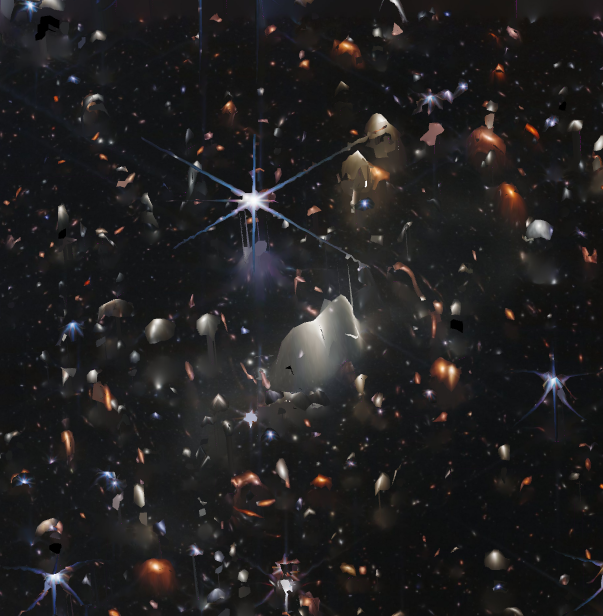
Yann Lechelon added a 3D photo to The James Webb Space Telescope (JWST). A 3D pseudo-image of "Webb First Deep Field"
Get the CuriosityStream x Nebula bundle deal for just 11.59 until December 24th, 2021 New streaming platform: Vlog channel: Patreon: Facebook: Instagram: Reddit: Twitter: Discord: Get your Real Engineering shirts at: Credits: Writer/Narrator: Brian McManus Editor: Dylan Hennessy Animator: Mike Ridolfi Sound: Graham Haerther Thumbnail: Simon Buckmaster (Twitter) References: [1] Epoch Reionization (PDF) [2] The James Webb Space Telescope will be launched on an Ariane 5 rocket, one of the world's most reliable launch vehicles. [3] JWST will orbit the sun, a million miles away from Earth at the second Lagrange point. [4] ..Thanks to the sunshield, the temperature is roughly 600 degrees Fahrenheit less on the cold, shaded side of the observatory than it is on the hot, sunlit side. [5] Webb deploys a tennis-court sized Sunshield made of five thin layers of Kapton E with aluminum and doped-silicon coatings to reflect the sun's heat back into space. [6] Advanced material keeps heat off new space telescope [7] The lowermost surfaces are coated with silicon, making the underside of the Kapton sunshield pink in tone. (TWITTER POSTING) [8]] Webb unfolding sequence [9] NASA’s Webb Telescope Packs Its Sunshield for a Million Mile Trip [10] Thanks to the sunshield, the temperature is roughly 600 degrees Fahrenheit less on the cold, shaded side of the observatory than it is on the hot, sunlit side. [11] Webb's MIRI instrument carries detectors that need to be at a temperature of less than 7 kelvin to operate properly. This temperature is not possible on Webb by passive means alone, so Webb carries an innovative "cryocooler" that is dedicated to cooling MIRI's detectors. [12] Investigation of a high frequency pulse tube cryocooler driven by a standing wave thermoacoustic engine [13] The Coolest Technology: Cryocoolers [14] A telescope's sensitivity, or how much detail it can see, is directly related to the size of the mirror area that collects light from the objects being observed. Webb's primary mirror is 6.5 meters (21 feet 4 inches) across; a mirror this large has never before been launched into space. [15] An Insight to Beryllium [16] The Beryllium Science & Technology Association [17] The "Not So Heavy Metal Video": James Webb Space Telescope's Beryllium Mirrors [18] All of the key questions answered about Webb targeted for the general interest level. [19] Hubble's Mirror Flaw [20] JWST Telescope [21] JWST Attitude Control Subsystem [22] JWST Propulsion Select imagery/video supplied by Getty Images Thank you to AP Archive for access to their archival footage. Music by Epidemic Sound: Thank you to my patreon supporters: Adam Flohr, Henning Basma, Hank Green, William Leu, Tristan Edwards, Ian Dundore, John & Becki Johnston. Nevin Spoljaric, Jason Clark, Thomas Barth, Johnny MacDonald, Stephen Foland, Alfred Holzheu, Abdulrahman Abdulaziz Binghaith, Brent Higgins, Dexter Appleberry, Alex Pavek, Marko Hirsch, Mikkel Johansen, Hibiyi Mori. Viktor Józsa, Ron Hochsprung
JWST has imaged the famous Hubble Ultra Deep Field, and it produced the same depth image in just 10% of the time. Come check out what it saw (HINT: it's a lot of galaxies!). You can buy me a coffee if you enjoyed this and want to support these videos. You don't have to though, no pressure LINKS: Full resolution available here: Gaps in JWST images explained: • Why Is There a GAP In This JWST Image?! Spikes Explained: Why are JWST Stars so SPIKY?! | Diffraction Spikes Explained Hey team! If there is some other cool topic in physics you think we should learn about together, leave a comment down below! Until next time, stay safe. Please consider subscribing if you enjoyed the video, and you can also find me on Twitter and Instagram: / chrisdpattison Twitter / chrispattison22 Instagram
Webb Makes First Detection of Crucial Carbon Molecule A team of international scientists has used NASA’s James Webb Space Telescope to detect a new carbon compound in space for the first time. Known as methyl cation (pronounced cat-eye-on) (CH3+), the molecule is important because it aids the formation of more complex carbon-based molecules. Methyl cation was detected in a young star system, with a protoplanetary disk, known as d203-506, which is located about 1,350 light-years away in the Orion Nebula. Carbon compounds form the foundations of all known life, and as such are particularly interesting to scientists working to understand both how life developed on Earth, and how it could potentially develop elsewhere in our universe. The study of interstellar organic (carbon-containing) chemistry, which Webb is opening in new ways, is an area of keen fascination to many astronomers. Credit: Webb Makes First Detection of Crucial Carbon Molecule ✨James Webb Space Telescope live position and data. James Webb Space Telescope is currently in the constellation of Virgo. Credit: The sky live JWST TRACKER Donate to (theskylive.com) Donate to Iacopo Sassarini Hello, I am the creator and maintainer of theskylive.com. Your donation is critical to help cover hosting costs and keep this site alive. Thank you ✨ Image Credit: ESA/Webb, NASA ✨Thanks so much for our members: freddy S Vijay Clube Rural do Brasil Philippe Huyse tom mayes salih alaca raul silva Nicholas Marin Murat Öke Pe Ka Desert Wind David Grossman Synth_32 Michael Douglas Kim Jones ✨Join this channel to get access to perks: ✨My Dear Moderators, many thanks for your time and contributions to this channel. ✨Disclaimer: This video is for educational purpose only. Copyright Disclaimer Under Section 107 of the Copyright Act 1976, allowance is made for "fair use" for purposes such as criticism, comment, news reporting, teaching, scholarship, and research Fair use is a use permitted by copyright statute that might otherwise be infringing Non-profit, educational or personal use tips the balance in favor of fair use. ✨Contact: : Twitter CONTACT VIA Email:
Check out more predictions on Earth 2050 at The James Webb Space Telescope is the most powerful space telescope ever. When is the JWST launching? And what will the JWST capabilities be? John Michael Godier spoke to Klaus Pontoppidan about the James Webb Space Telescope and just how it will change everything once it is observing our galaxy and the universe. 00:00:00 Intro 00:00:40 Earth 2050 00:02:35 Bio 0:08:40 Is Solar Pressure an issue? 00:10:08 Can the James Webb Space Telescope be Serviced? 00:11:12 What will JWST be observing? 00:15:00 Killanova 00:18:40 How much bigger is the JWST compared to the Hubble 00:23:17 Why infrared was chosen for the JWST 00:25:02 Hot Jupiters 00:29:20 Classifying Exoplanets 00:31:50 Studying Transient Events 00:33:47 Studying interstellar objects 00:39:50 Studying our outer solar system planets and moons 00:48:50 Looking at the Traapist system 00:51:20 Techno and Biosignatures Want to support the channel? Follow us at other places! : Patreon: Website Instagram: Music featured on Event Horizon Stelladrome Miguel Johnson Leersevere Aeriumambient FOOTAGE: NASA ESA/Hubble ESO - M.Kornmesser ESO - L.Calcada ESO - Jose Francisco Salgado (josefrancisco.org) NAOJ University of Warwick Goddard Visualization Studio Langley Research Center Pixabay #jameswebbspacetelescope #jwst
Will The James Webb Telescope Finally Be Launched. Decades of waiting have finally led us to this moment. Now, we are only a month away from witnessing history. The US, European, and Canadian space agencies have come together to create the James Webb Space Telescope dubbed by many as the “telescope that ate astronomy”. At 6.5 meters in diameter, it’s astronomical mirror is the largest ever and will unfold to reveal an origami-like structure. That is if the JSWT (James Webb Space Telescope) does, in fact, launch. Fingers crossed that it can finally begin its mission and leave our earthly world behind. But why has it taken so long to launch? And why are we now sure that it will be launched this December? Let’s find out in this video.
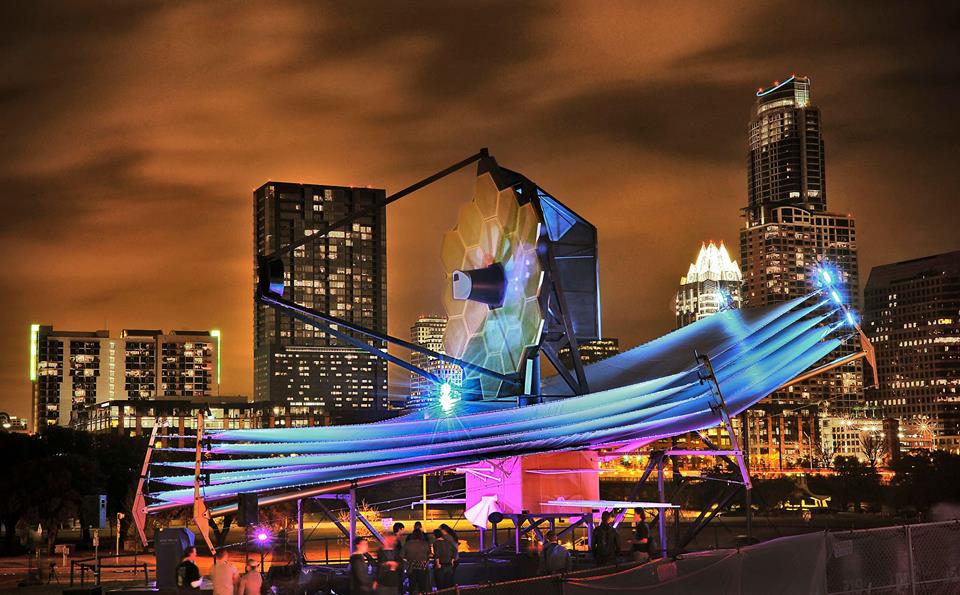
A full scale Mockup of the James Webb Telescope at the South by South West convention in Austin Texas.
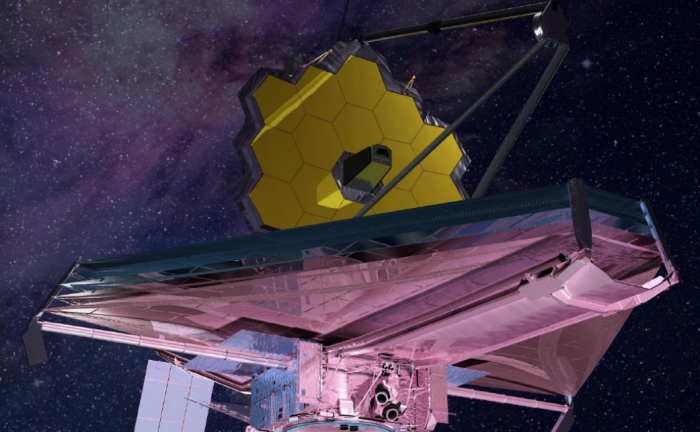
Illustration of NASA's James Webb Space Telescope(Final Deployment). Credits: NASA

Published on Apr 8, 2014 This video shows in-depth what will happen when James Webb Space Telescope deploys after launch. For more information, see this description on our website: http://jwst.nasa.gov/faq.html#howdeploy Download video: http://jwst.nasa.gov/videos/JWST_2014... (67 MB .wmv) http://jwst.nasa.gov/videos/JWST_2014... (169 MB .wmv) http://jwst.nasa.gov/videos/JWST_2014... (271 MB .wmv) http://jwst.nasa.gov/videos/JWST_2014... (92 MB .mp4) http://jwst.nasa.gov/videos/JWST_2014... (172 MB .mp4) http://jwst.nasa.gov/videos/JWST_2014... (118.9 MB iPad .mp4) http://jwst.nasa.gov/videos/JWST_2014... (132 MB Nexus 7 .mp4) Category Science & Technology License Standard YouTube License
NASA James Webb Space Telescope Tracking LIVE From Space | Instrument Modes Commissioning
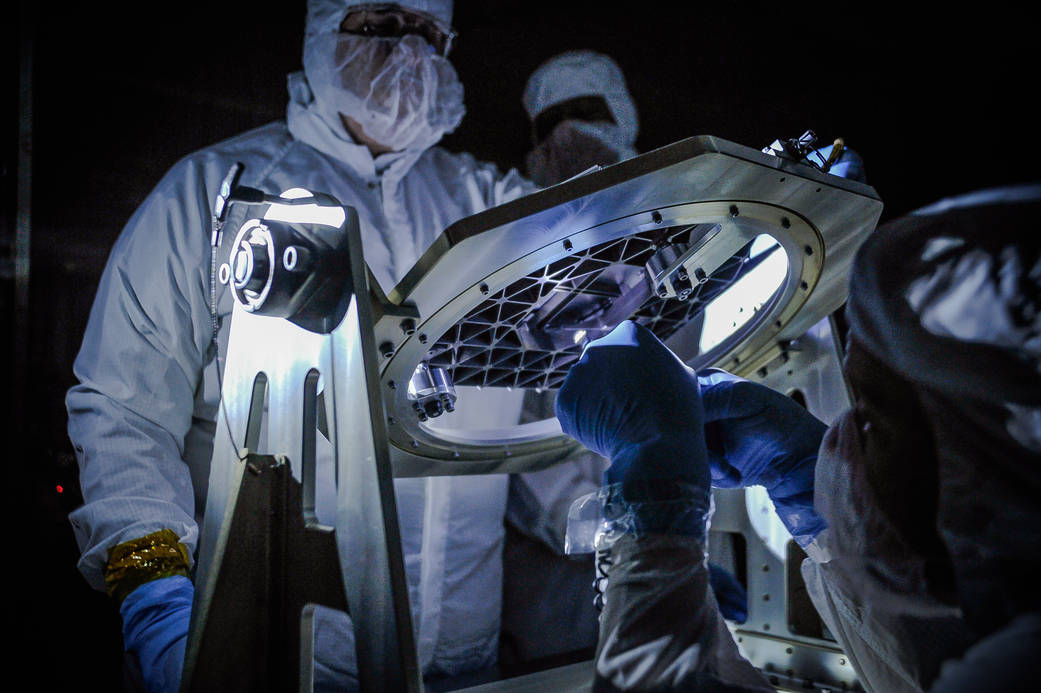
NASA engineers inspect a new piece of technology developed for the James Webb Space Telescope,
the micro shutter array, with a low light test at NASA's Goddard Space Flight Center in Greenbelt, Maryland.
Developed at Goddard to allow Webb's Near Infrared Spectrograph to obtain spectra of more than 100 objects in the
universe simultaneously, the micro shutter array uses thousands of tiny shutters to capture spectra from selected objects
of interest in space and block out light from all other sources.

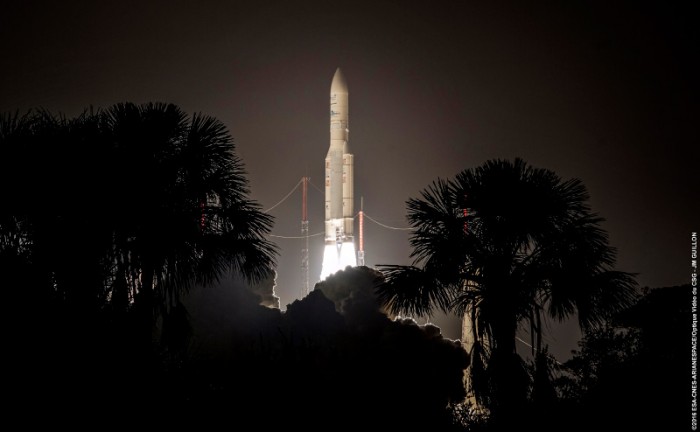
The Ariane5 lifting off from Kourou in French Guiana. Image: ESA/Arianespace.
Published on Jan 27, 2016 Arianespace has successfully launched Intelsat 29e for the international operator Intel-sat.
Arianespace’s first launch of the year, and its 56th performed for Intelsat, took place on
January 27 at 8:20 pm (local time) from the Guiana Space Center in Kourou, French Guiana.
This 70th success in a row for Ariane 5 initiates another ambitious year for Arianespace,
which is planning to launch up to eight Ariane 5 missions during 2016. Category Science & Technology License Standard YouTube License
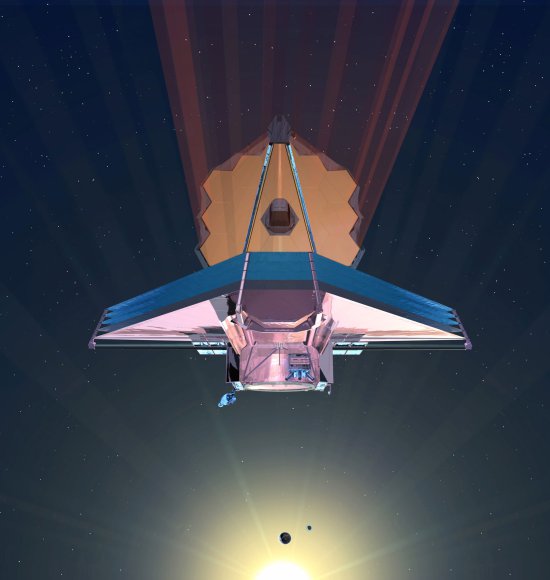
NASA’s James Webb Telescope, shown in this artist’s conception,
will provide more information about previously detected exoplanets. A new habitability index
is aimed at helping the Webb team prioritize its search.
Credit: NASA
Click Here for the
James Webb Observatory
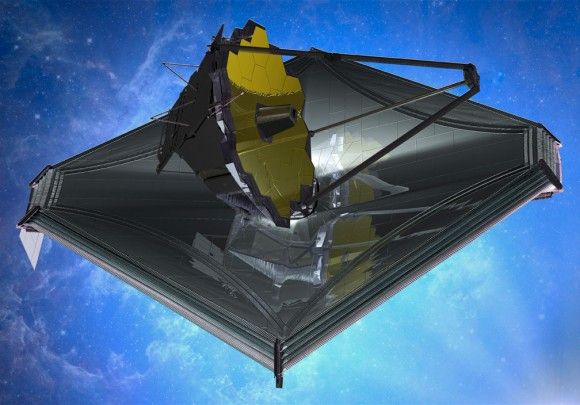
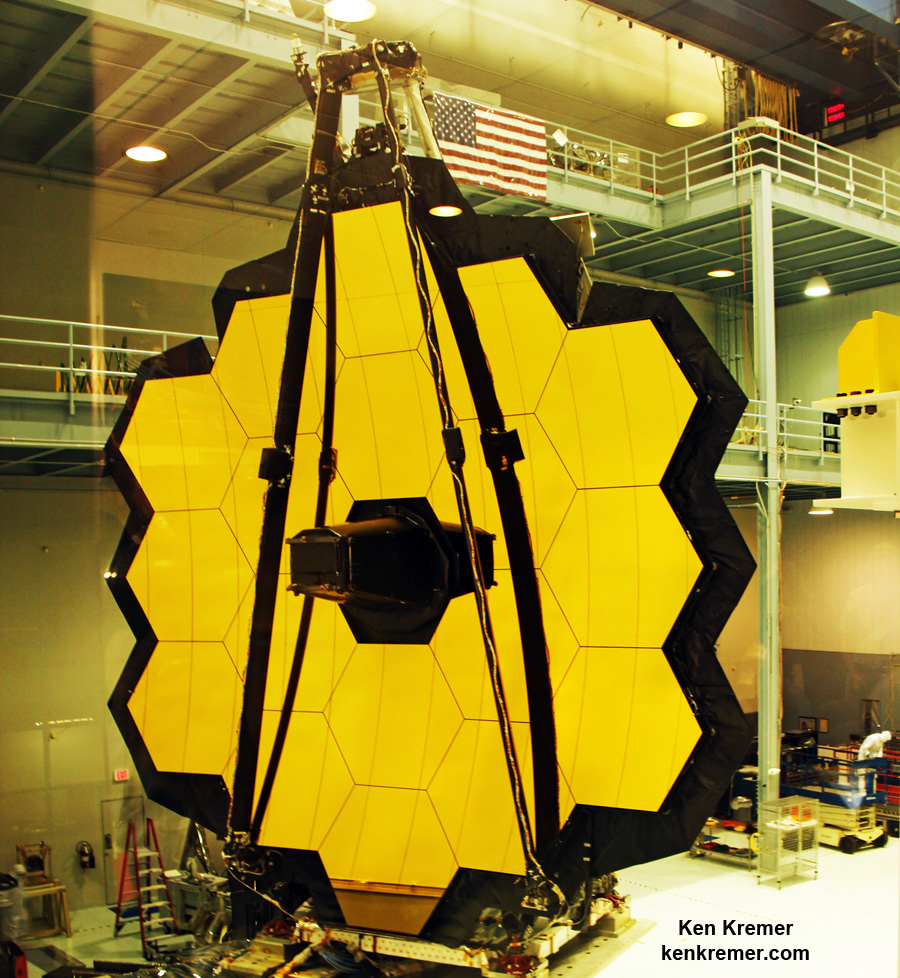
The 18-segment gold coated primary mirror of NASA’s James Webb Space Telescope is raised into vertical alignment in the largest clean room at the agency’s Goddard Space Flight Center in Greenbelt, Maryland, on Nov. 2, 2016. The secondary mirror mount booms are folded down into stowed for launch configuration. Credit: Ken Kremer/
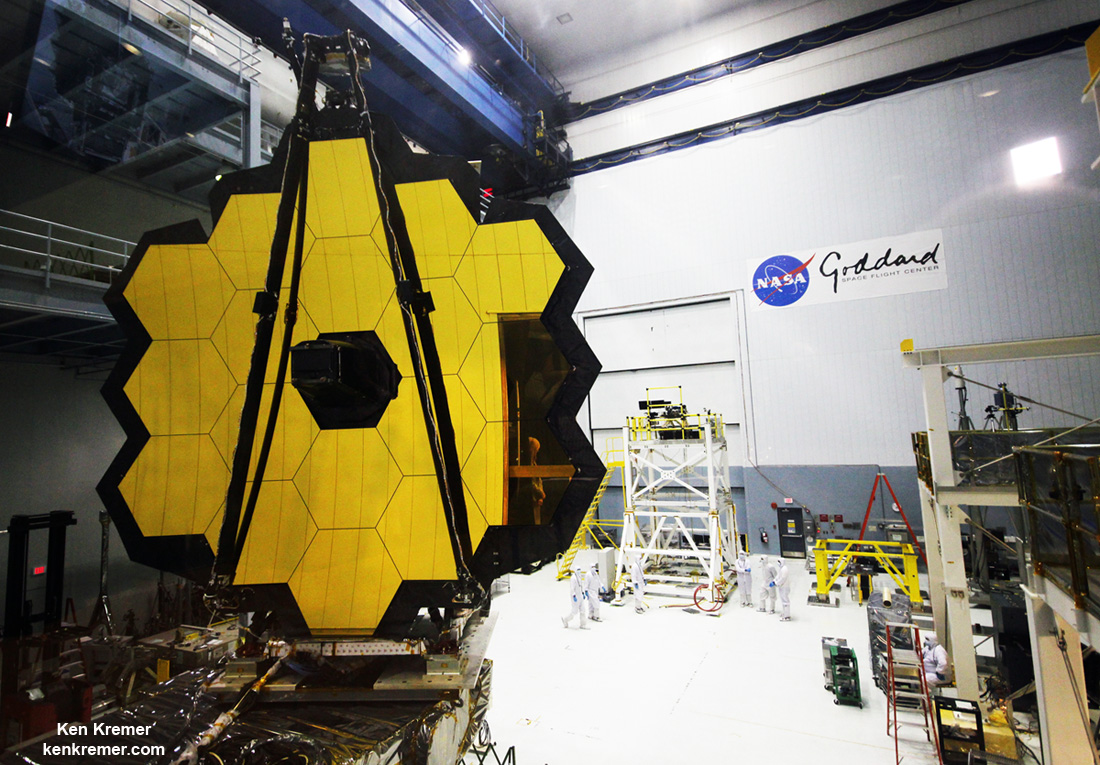
Technicians work on the James Webb Space Telescope in the massive clean room at NASA’s Goddard Space Flight Center, Greenbelt, Maryland, on Nov. 2, 2016, as the completed golden primary mirror and observatory structure stands gloriously vertical on a work stand, reflecting incoming light from the area and observation deck. Credit: Ken Kremer/
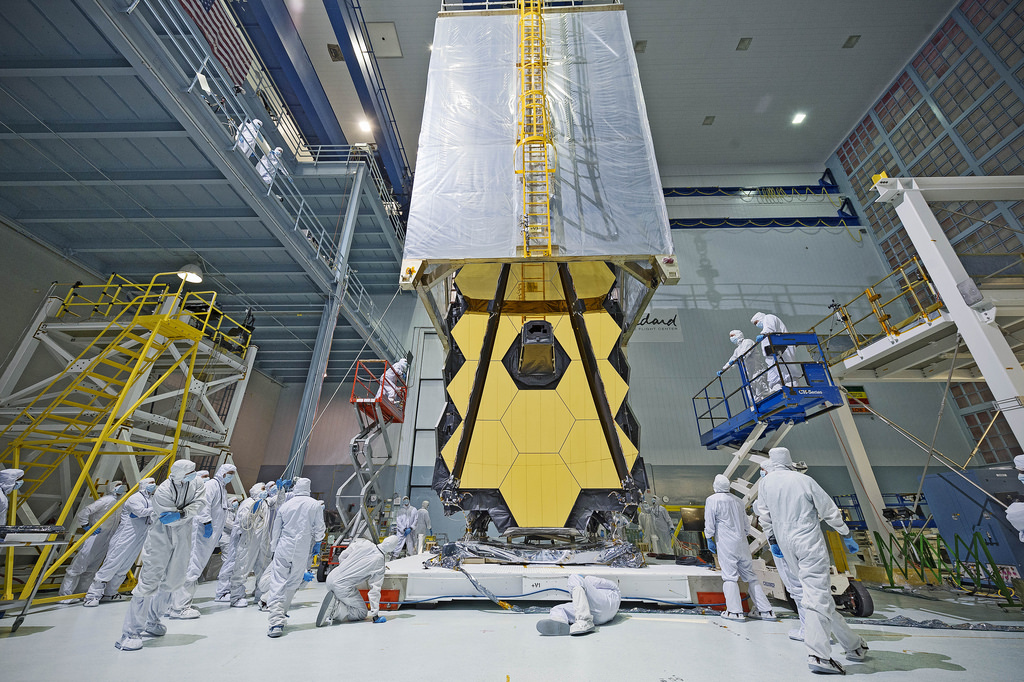
NASA’s James Webb Space Telescope placed inside a “clean tent” in Nov. 2016 to protect it from dust and dirt as engineers at NASA’s Goddard Space Flight Center in Greenbelt, Maryland transport it out of the relatively dust-free cleanroom and into a shirtsleeve environment to conduct vibration and acoustics tests to confirm it is fit for launch in 2018. Credit: NASA/Chris Gunn
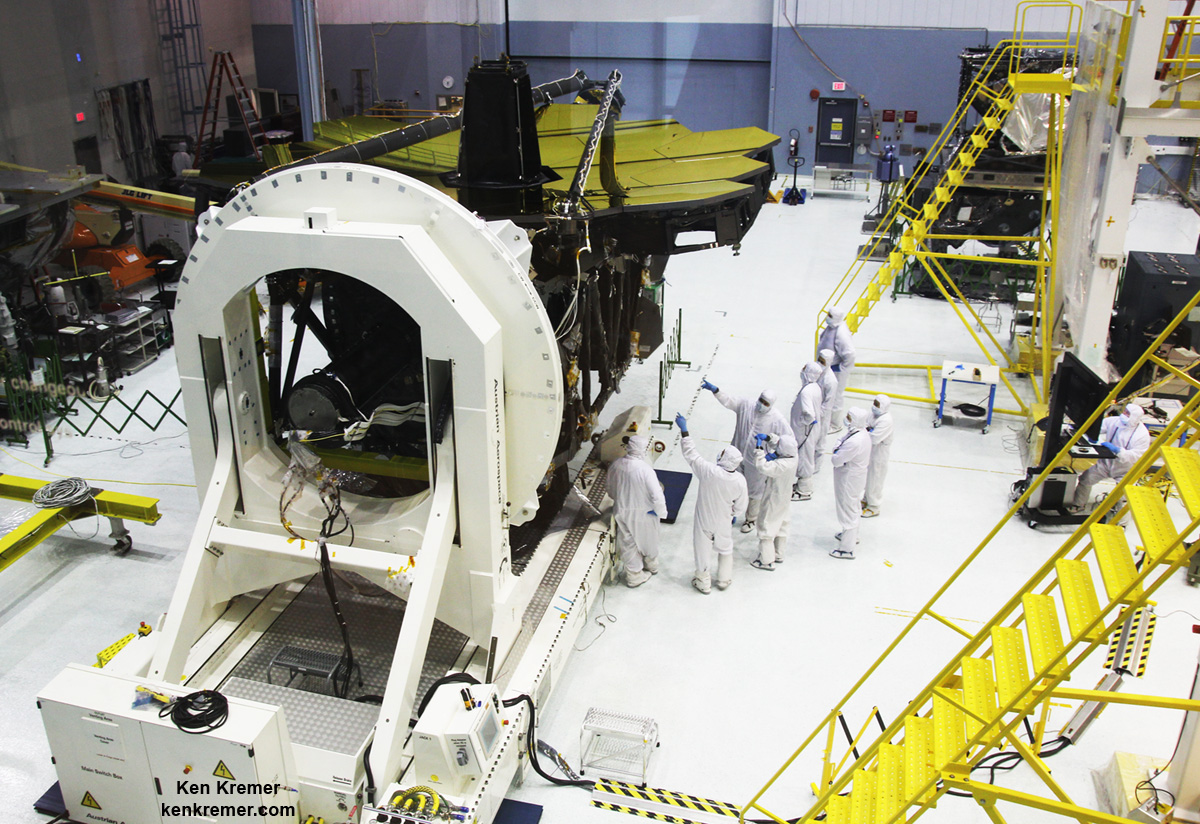
All 18 gold coated primary mirrors of NASA’s James Webb Space Telescope are seen fully unveiled after removal of protective covers installed onto the backplane structure, as technicians work inside the massive clean room at NASA’s Goddard Space Flight Center in Greenbelt, Maryland on May 3, 2016. The secondary mirror mount booms are folded down into stowed for launch configuration . Credit: Ken Kremer/
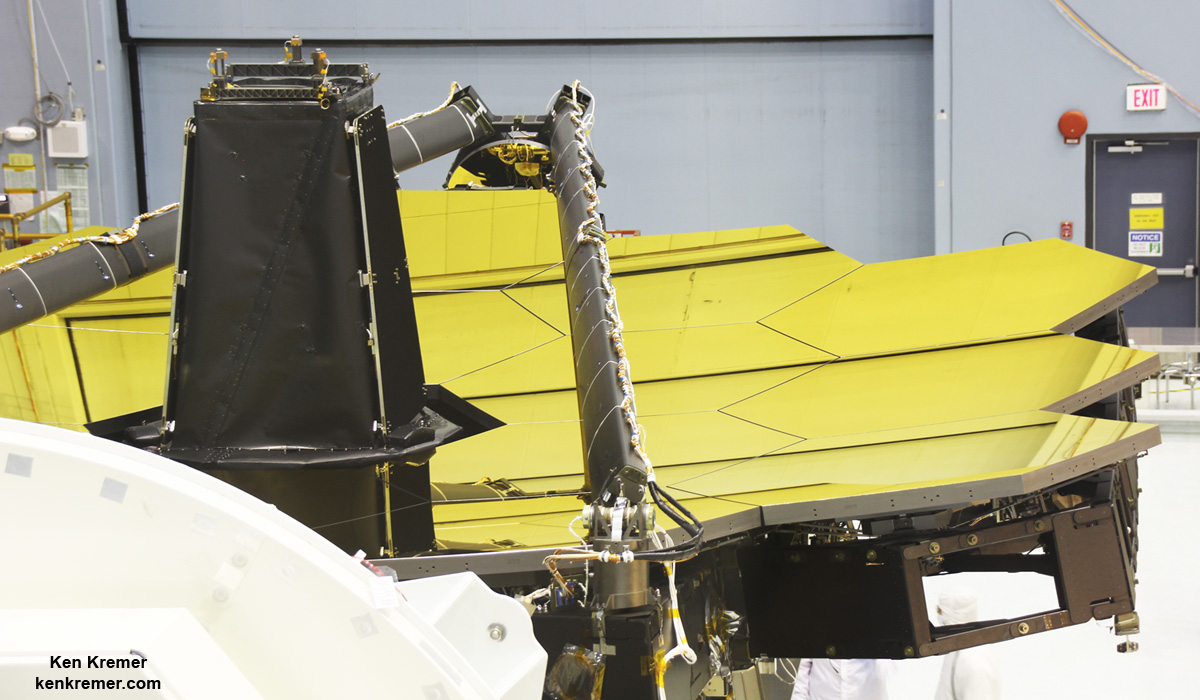
Up close side-view of newly exposed gold coated primary mirrors installed onto mirror backplane holding structure of NASA’s James Webb Space Telescope inside the massive clean room at NASA’s Goddard Space Flight Center in Greenbelt, Maryland on May 3, 2016. Aft optics subsystem stands upright at center of 18 mirror segments between stowed secondary mirror mount booms. Credit: Ken Kremer/
<
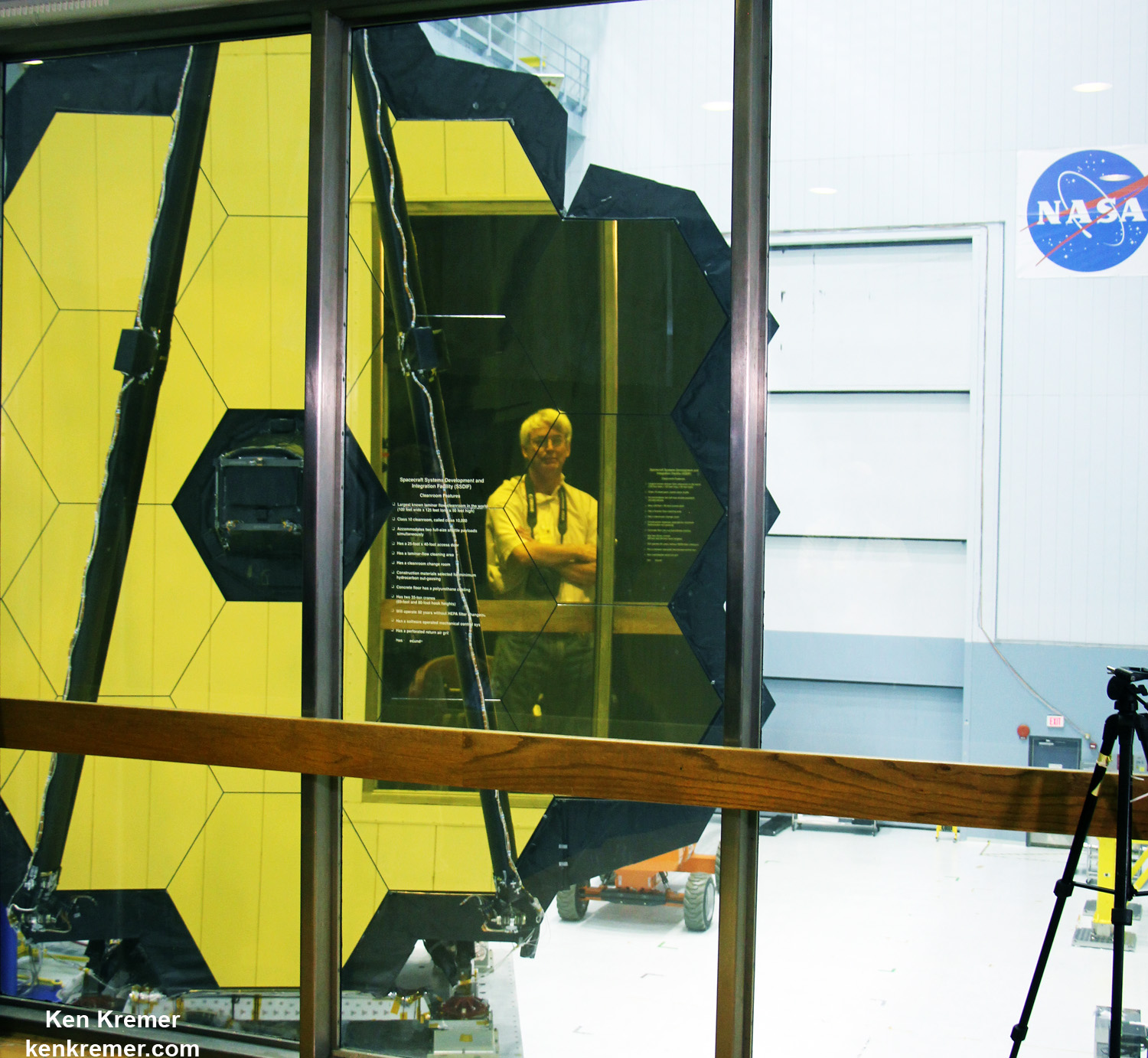
NASA Webb Telescope Resumes Rigorous Vibration Qualification Tests
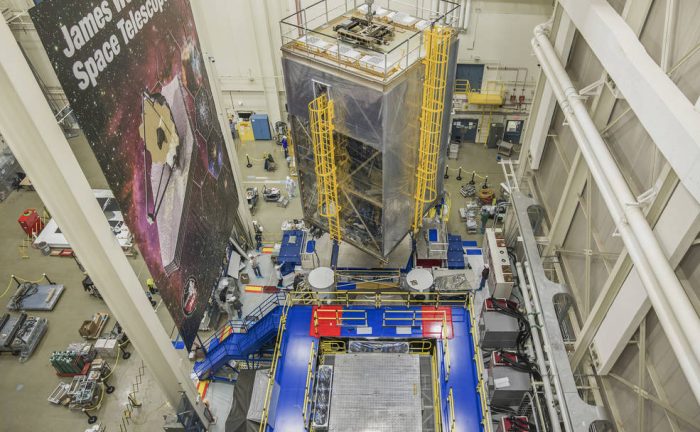
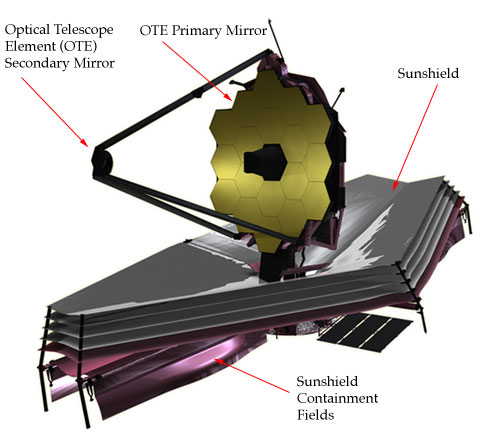
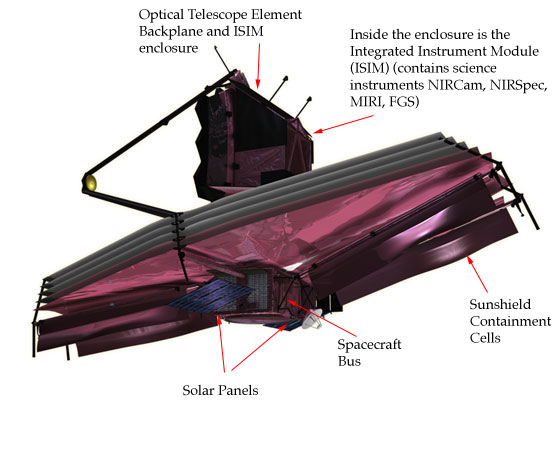
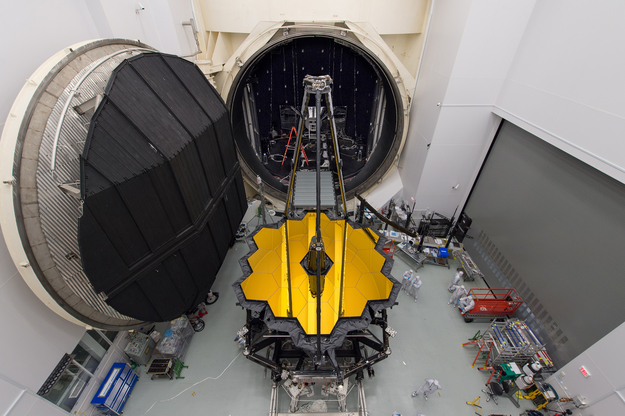

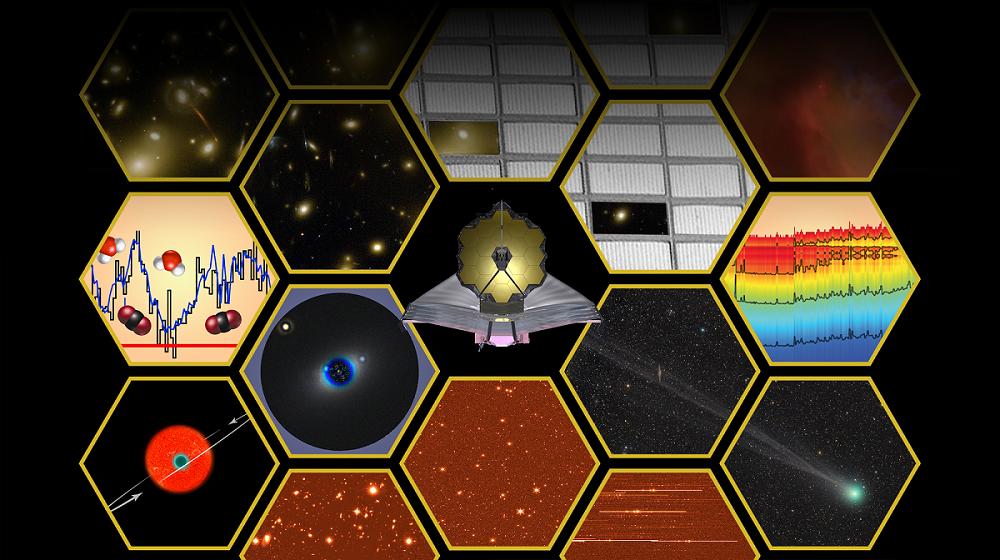
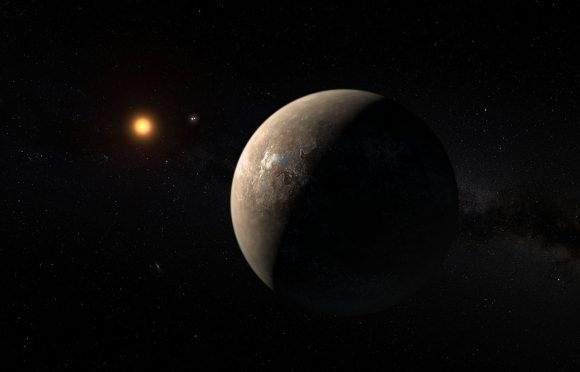
JAMES WEBB WRAPS UP 3 MONTHS IN THE FREEZER. IT’S READY FOR SPACE
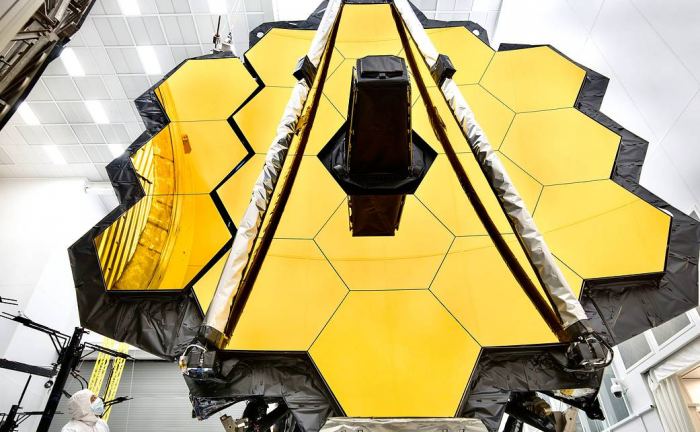
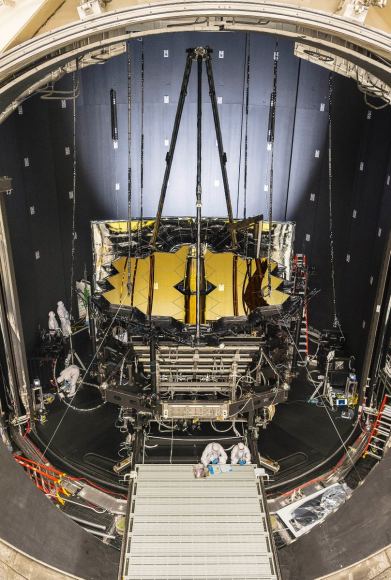
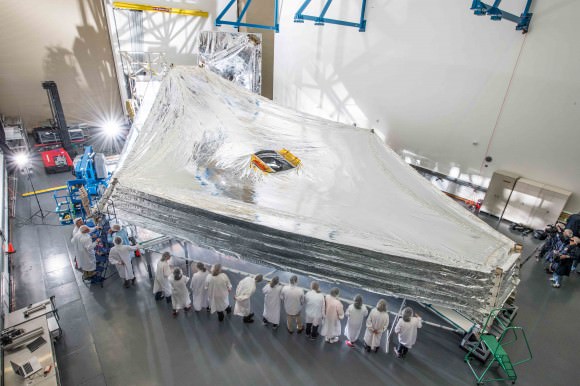
of Mirror Holding Backbone Flight Structure
by KEN KREMER on OCTOBER 8, 2015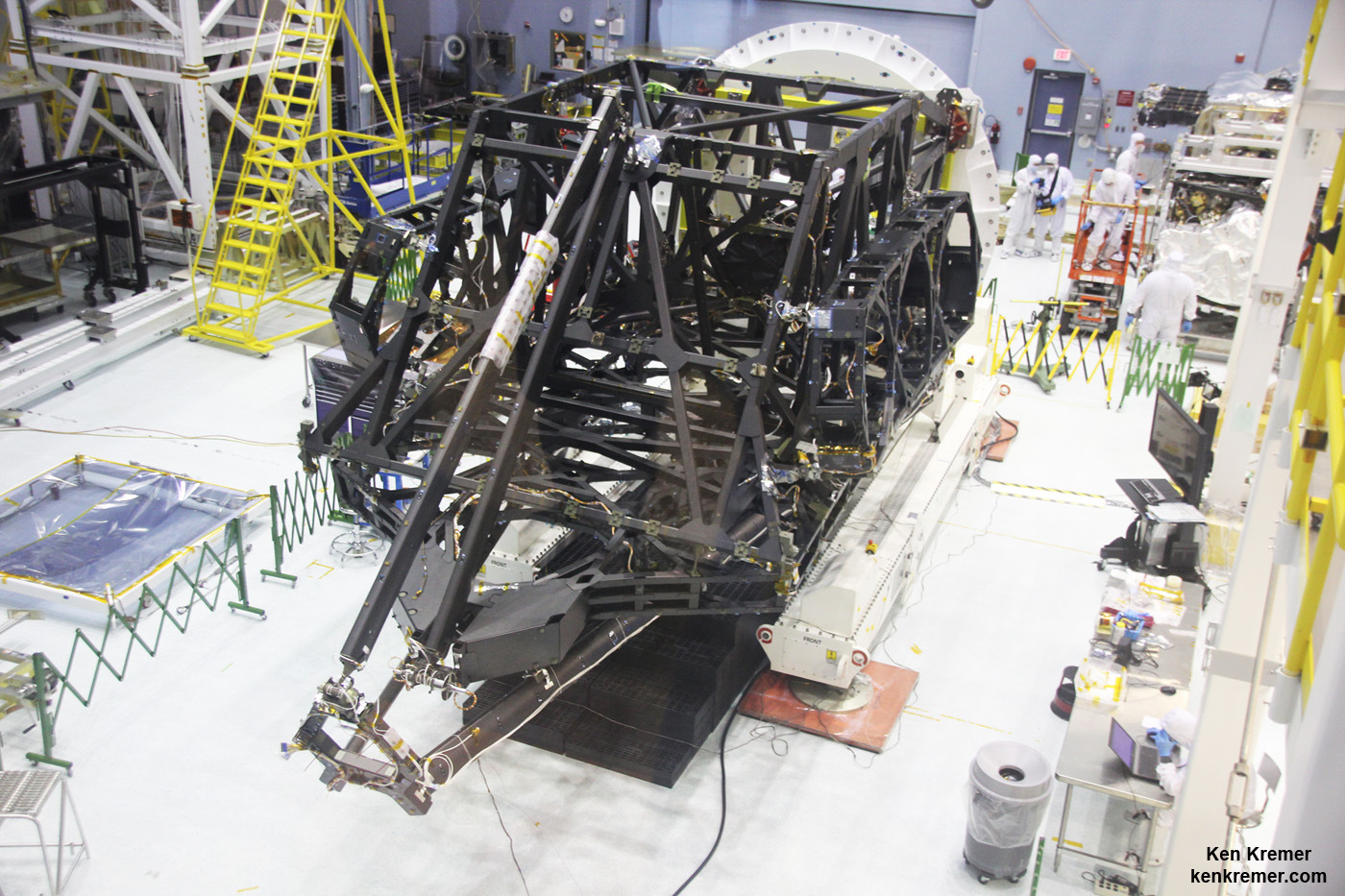
that holds 18 segment primary mirror array and secondary mirror mount at front, in stowed-for-launch configuration.
JWST is being assembled here by technicians inside the world’s largest cleanroom at NASA Goddard Space Flight Center, Greenbelt, Md.
Credit: Ken Kremer.com
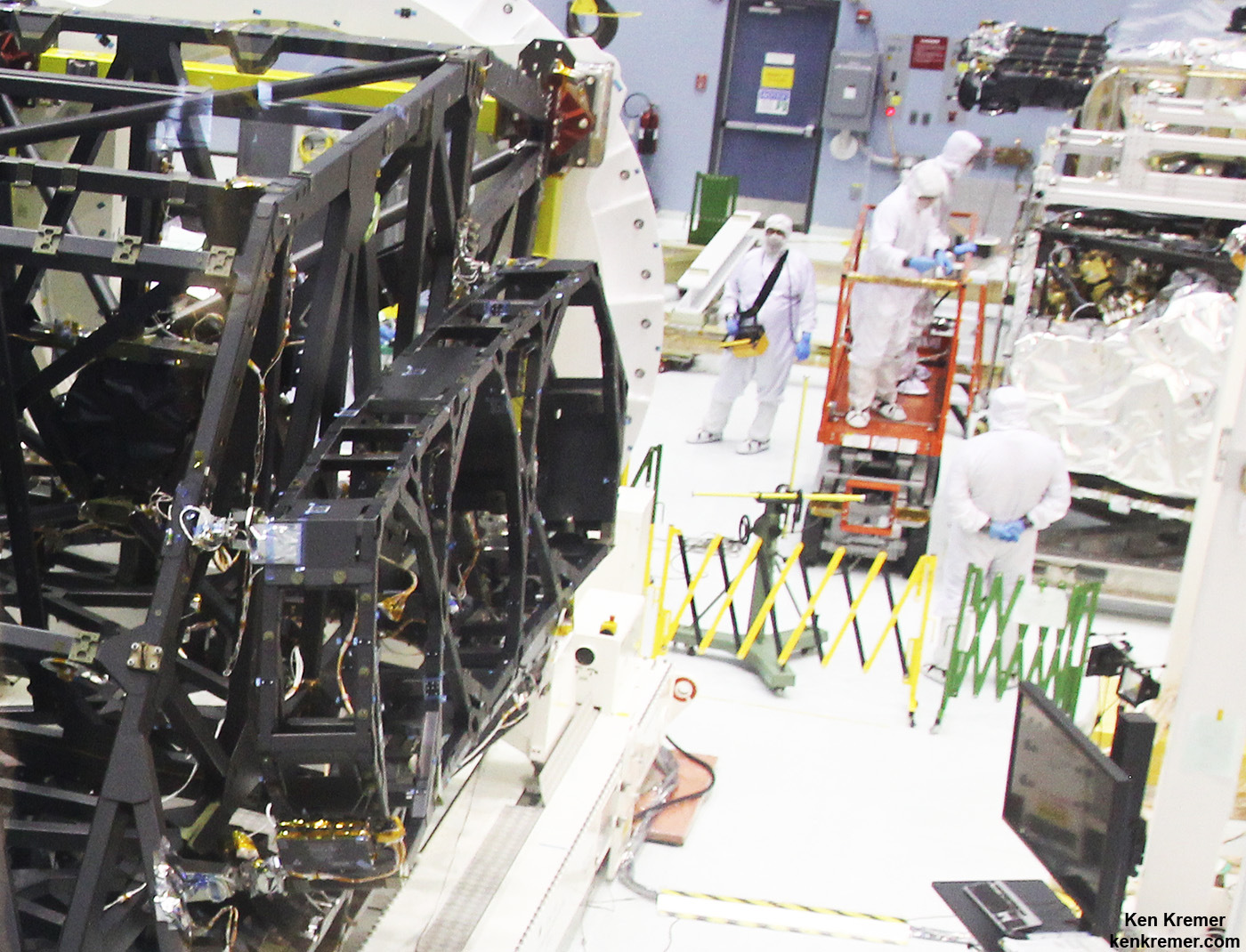
that will hold 3 of the observatory’s 18 primary mirrors, as technicians work inside cleanroom
at NASA Goddard Space Flight Center, Greenbelt, Md.
Credit: Ken Kremer.com
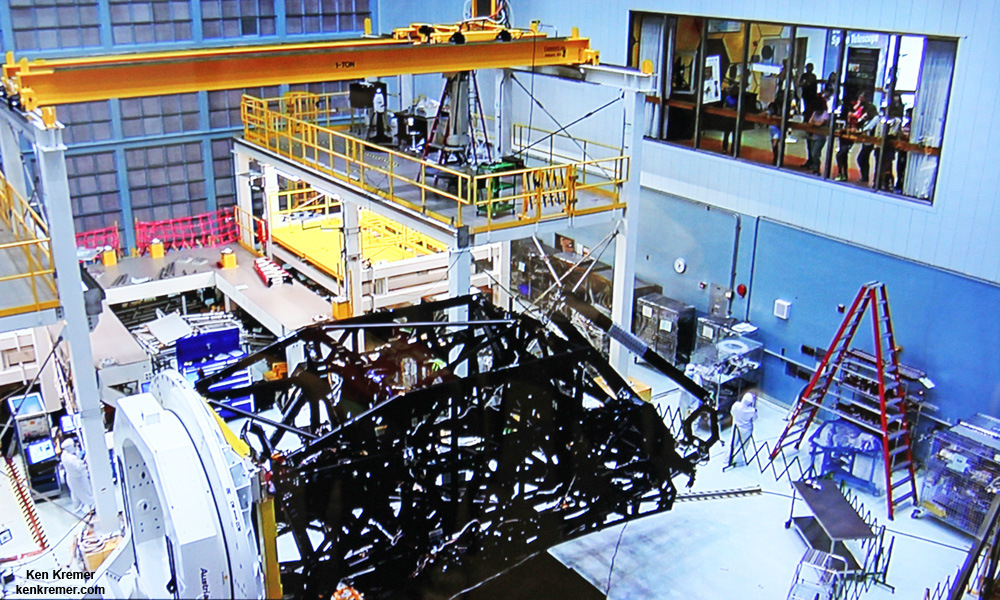
that holds primary mirror array and secondary mirror mount in stowed-for-launch configuration.
JWST is being assembled technicians inside the cleanroom at NASA Goddard Space Flight Center, Greenbelt, Md.
Credit: Ken Kremer.com
First Mirror Installed on NASA’s Webb Telescope, Final Assembly Phase Starts
by Ken Kremer on November 25, 2015
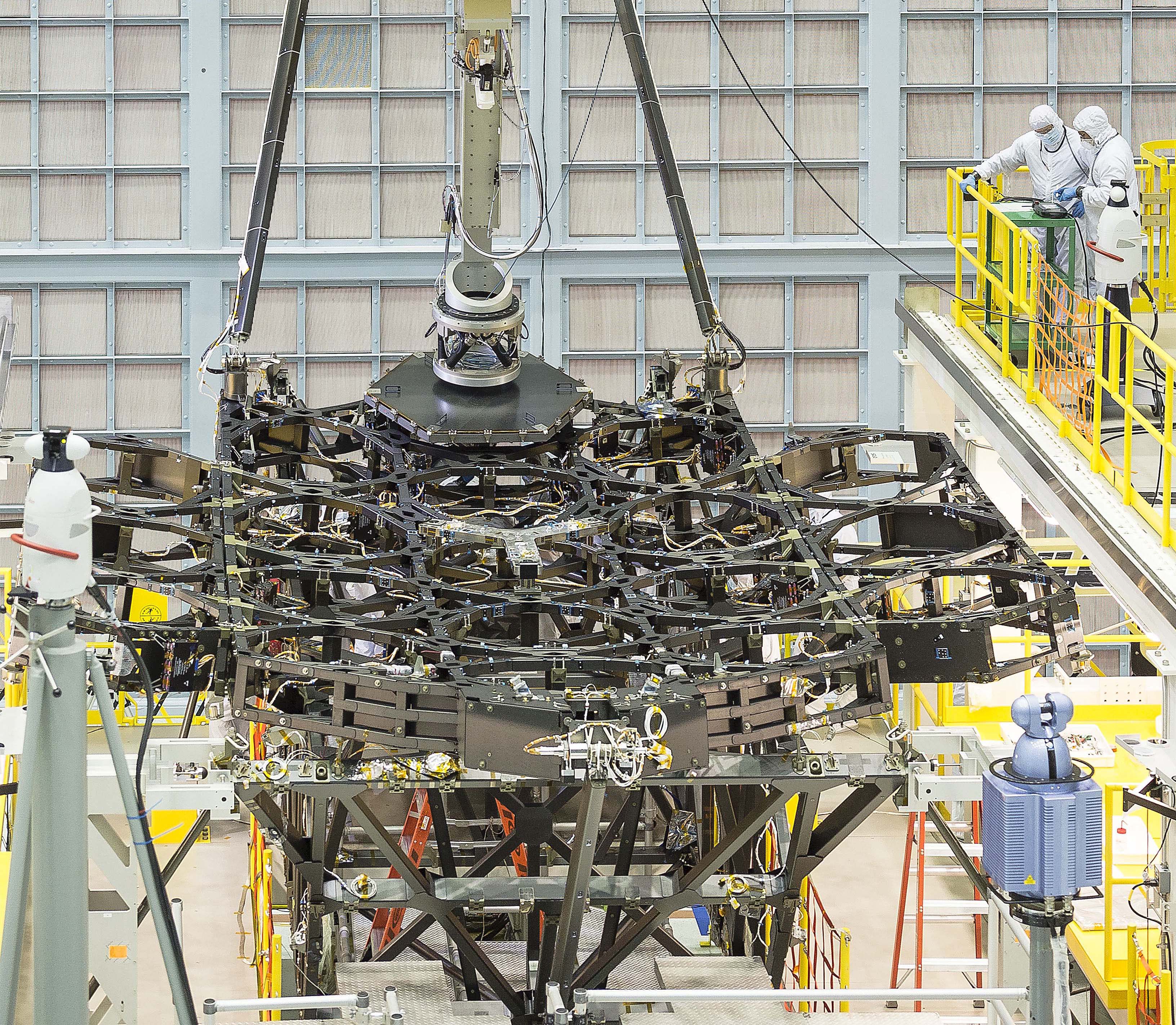
at NASA’s Goddard Space Flight Center in Greenbelt, Maryland. Credits: NASA/Chris Gunn
Story/photos updated
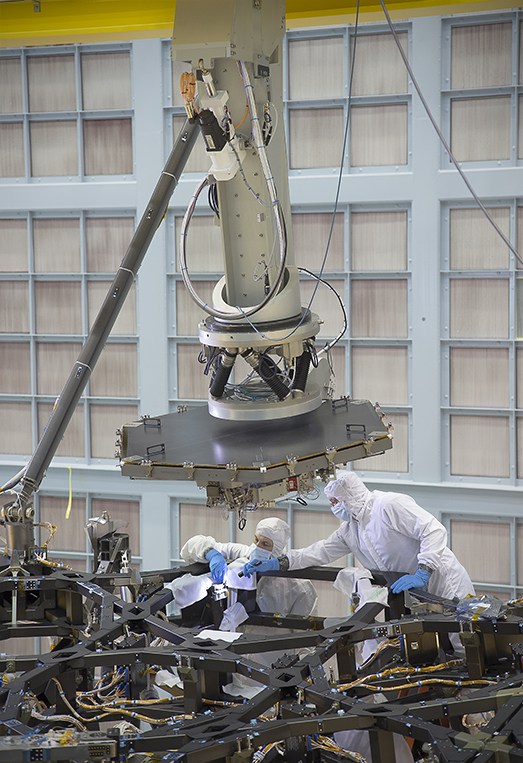
the James Webb Space Telescope Team prepared for the first flight mirror’s installation onto the telescope structure.
Credits: NASA/Chris Gunn
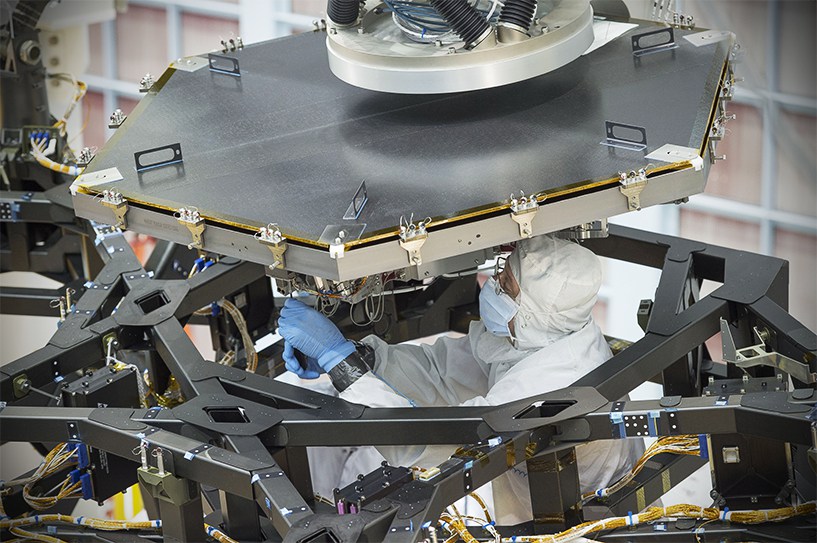
NASA’s Goddard Space Flight Center in Greenbelt, Maryland. Credits:
NASA/Chris Gunn

backplane and secondary mirror tripod assembly in 2014 inside the clean room at NASA Goddard Space Flight Center, Greenbelt, Md.
Secondary mirror at top.
Credit: Ken Kremer.com
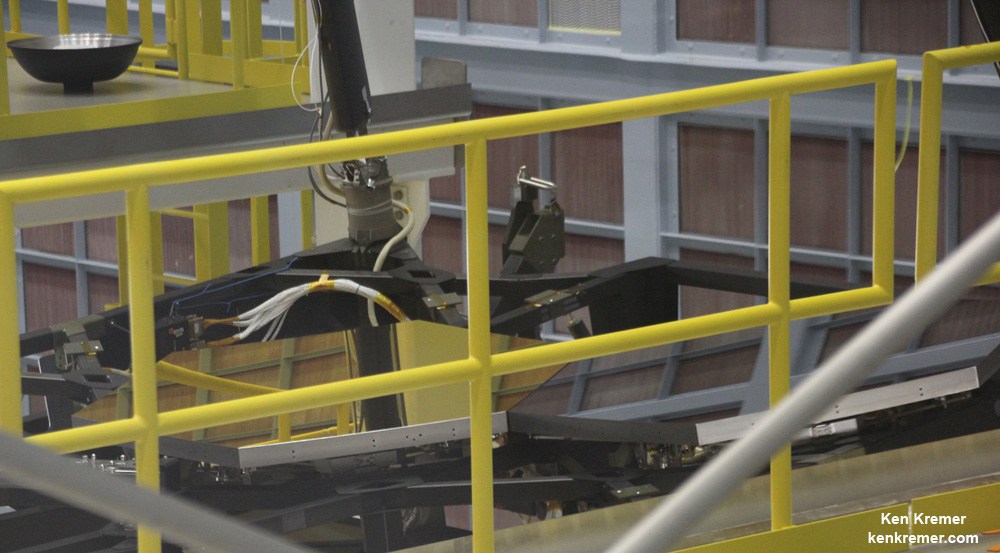
during practice session in 2014 inside the clean room at NASA Goddard Space Flight Center,
Credit: Ken Kremer.com
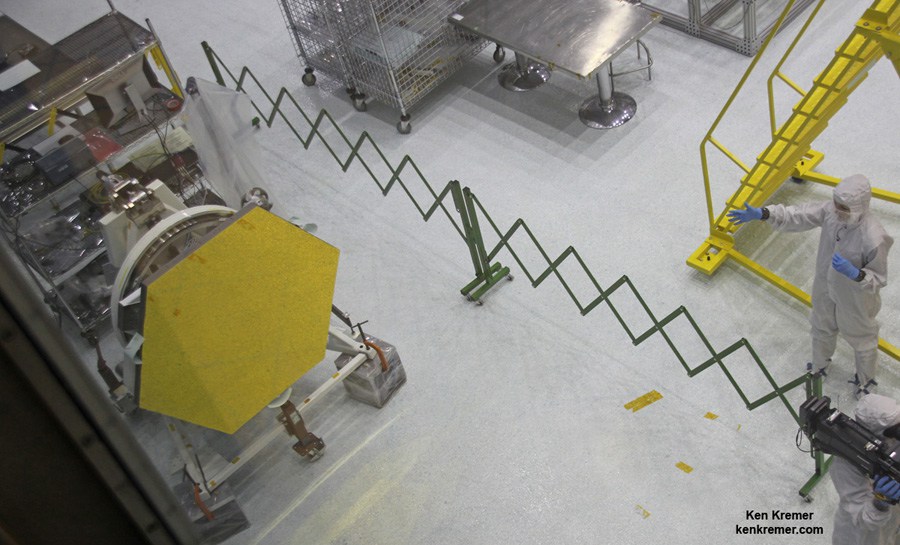
and used for test operations inside the NASA Goddard clean room.
Credit: Ken Kremer.com
Time-lapse: The Assembly of the James Webb Space Telescope Primary Mirror
JWST is the scientific successor to NASA's Hubble Space Telescope. It will be the most powerful space telescope ever built.
Webb will study many phases in the history of our universe, including the formation of solar systems capable of supporting
life on planets similar to Earth, as well as the evolution of our own solar system. It’s targeted to launch from French Guiana aboard
an Ariane 5 rocket in 2018. Webb is an international project led by NASA with its partners, ESA (European Space Agency) and the
Canadian Space Agency.
Download video: https://svs.gsfc.nasa.gov/cgi-bin/det...
Credit: NASA's Goddard Space Flight Center
Category
Science & Technology
License
Standard YouTube License
JAMES WEBB SPACE TELESCOPE TAKES THE GLOVES OFF
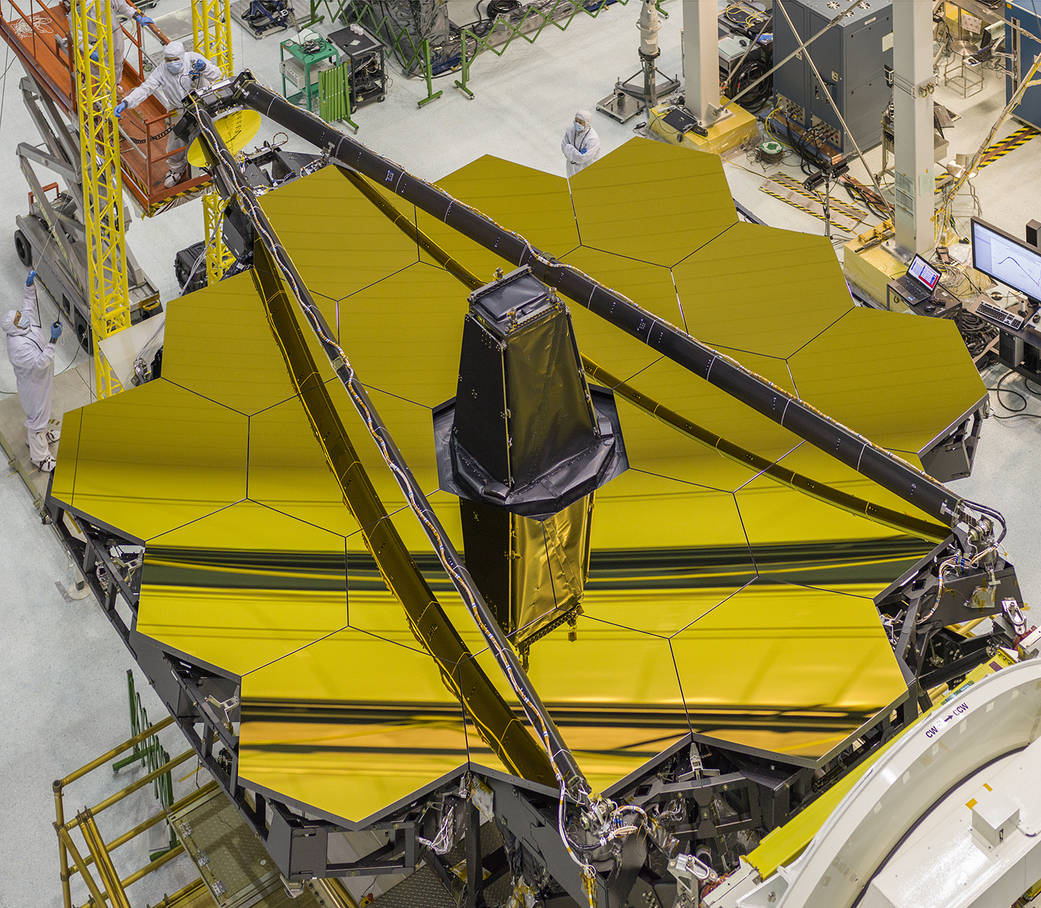
Image: NASA/Chris Gunn
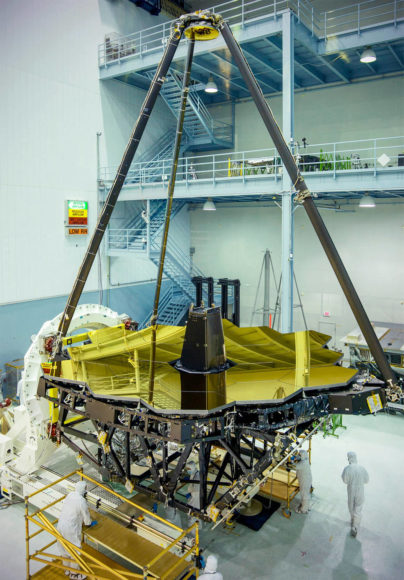
over 13 billion years ago.WEBB TELESCOPE GETS ITS SCIENCE INSTRUMENTS INSTALLED
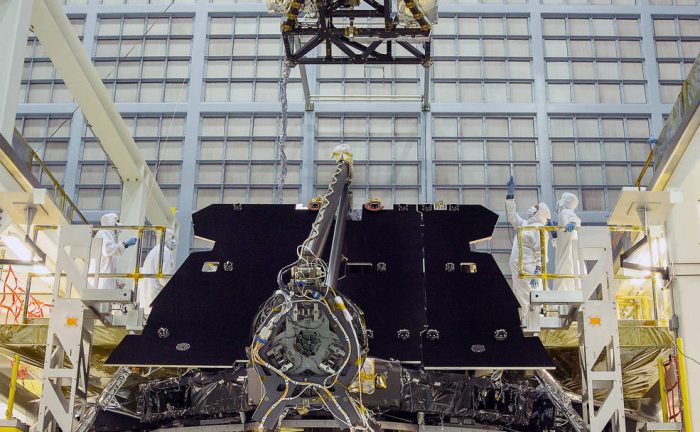
for installation into the telescope structure. Credits: NASA/Chris Gunn
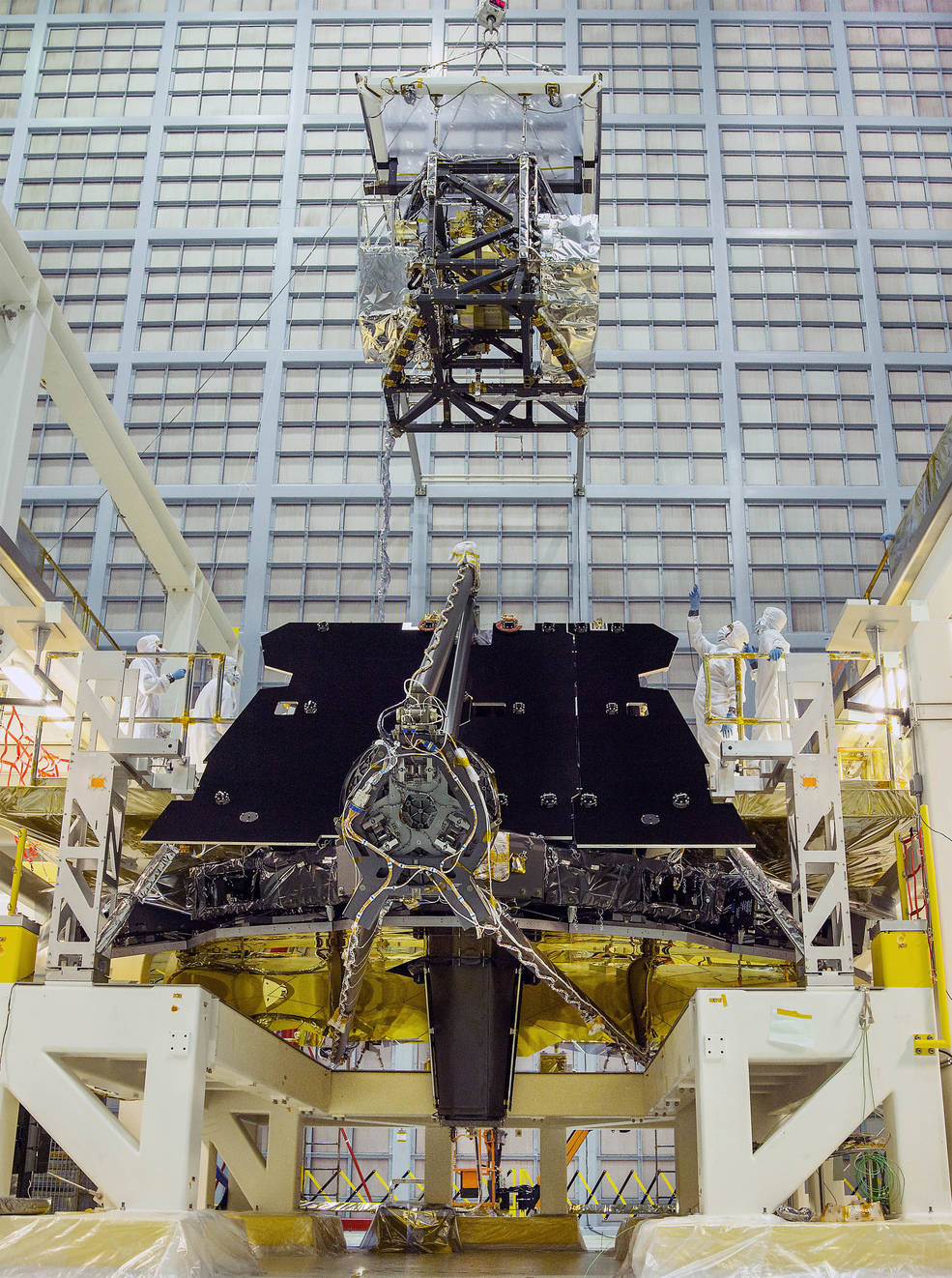
for installation into the telescope structure. Credits: NASA/Chris Gunn

Greenbelt, Maryland where the James Webb Space Telescope team worked meticulously to complete the science instrument package installation.
Credits: NASA/Desiree Stover
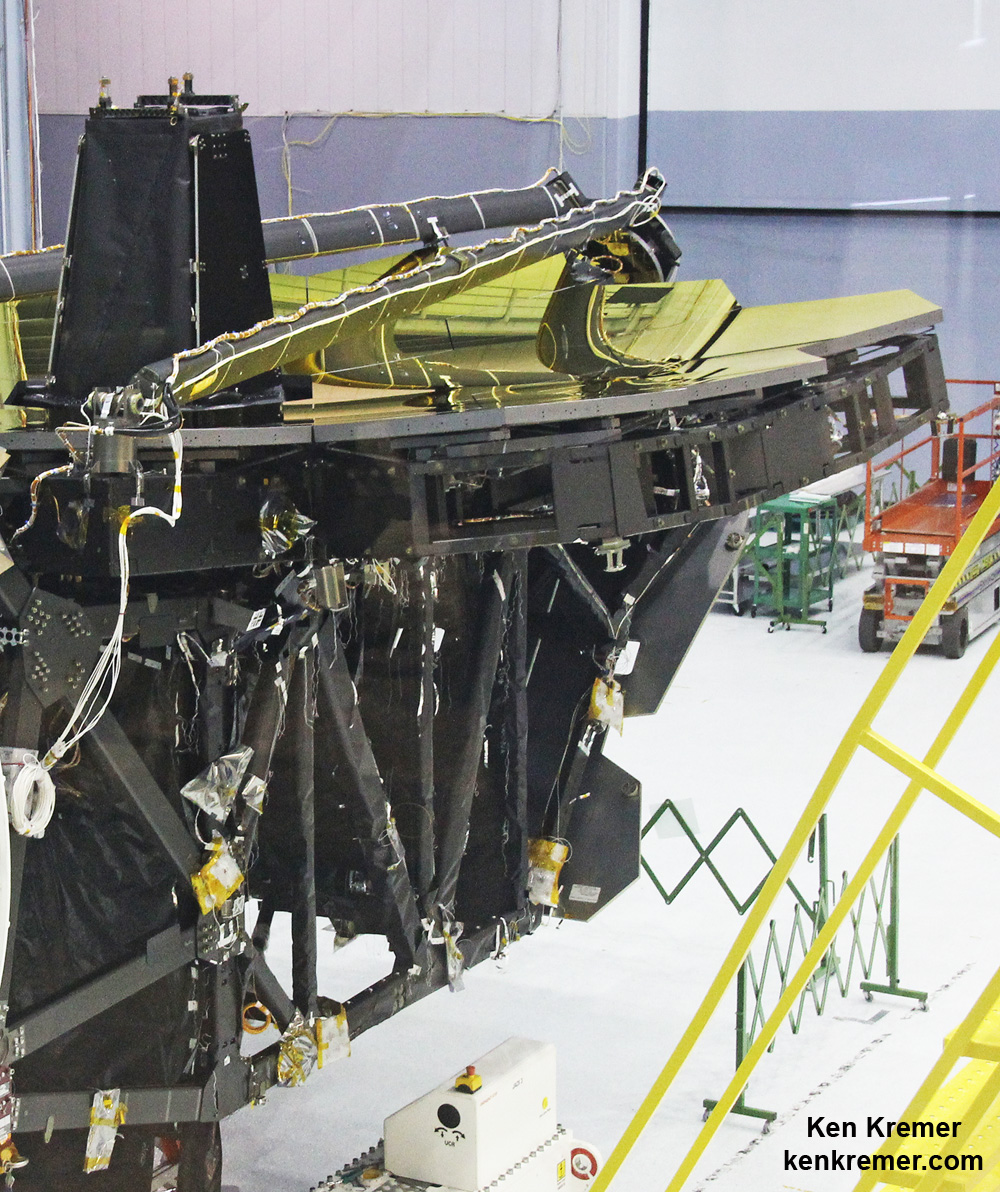
at NASA’s Goddard Space Flight Center in Greenbelt, Maryland on May 3, 2016. ISIM science instrument module will be installed
inside truss structure below. Credit: Ken Kremer/
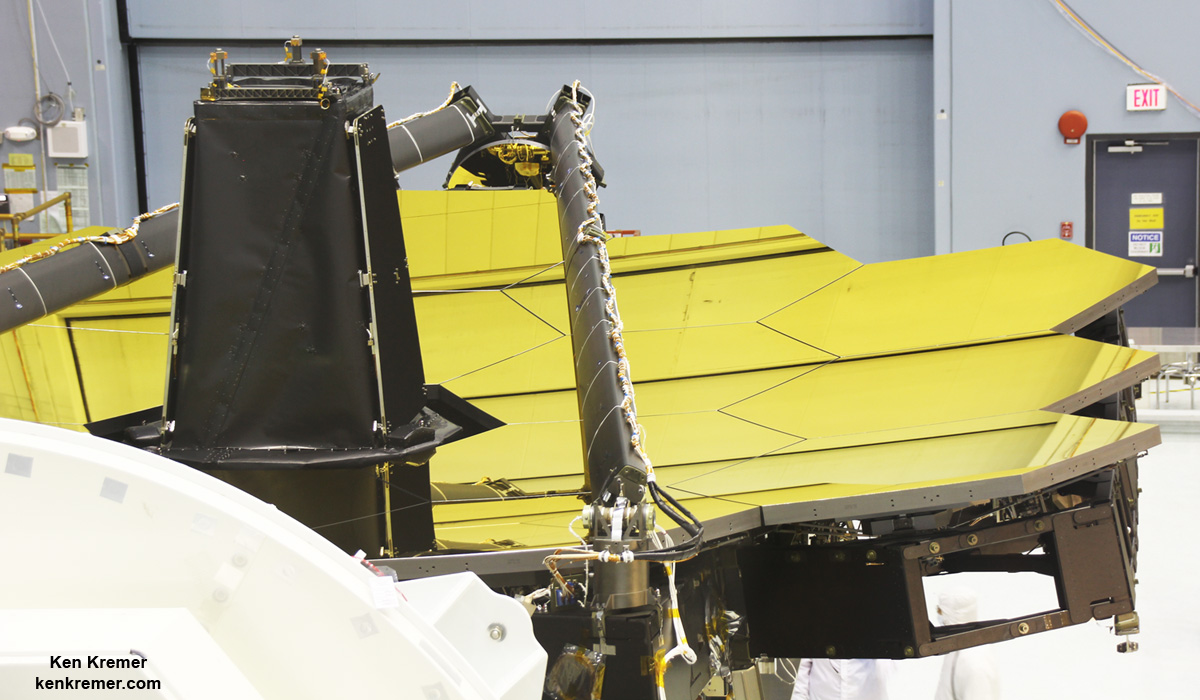
NASA’s James Webb Space Telescope inside the massive clean room at NASA’s Goddard Space Flight Center in Greenbelt, Maryland
on May 3, 2016. Aft optics subsystem stands upright at center of 18 mirror segments between stowed secondary mirror mount booms.
Credit: Ken Kremer/
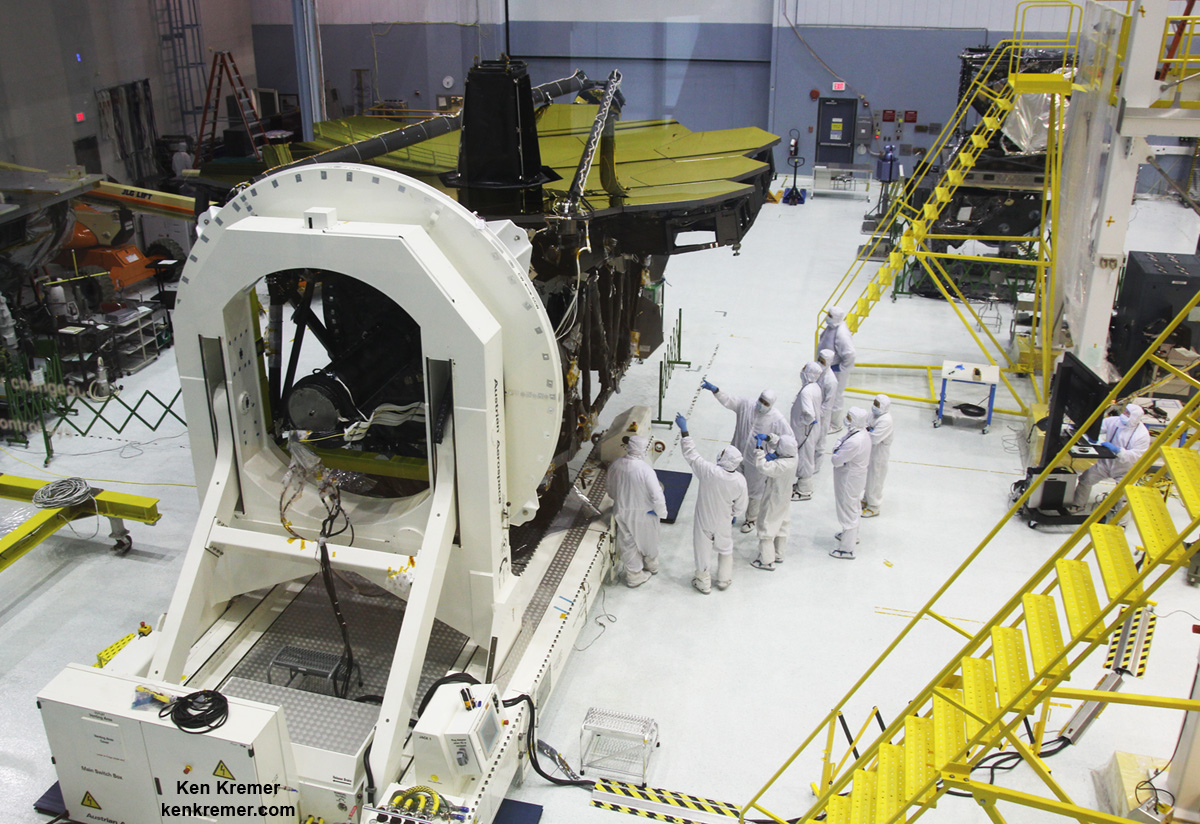
installed onto the backplane structure, as technicians work inside the massive clean room at NASA’s Goddard Space Flight Center
in Greenbelt, Maryland on May 3, 2016. The secondary mirror mount booms are folded down into stowed for launch configuration.
Credit: Ken Kremer/
Time-Lapse Tilting of Webb Telescope's Primary Mirror
in the largest clean room at the agency's Goddard Space Flight Center in Greenbelt, Maryland, on May 4, 2016.
The James Webb Space Telescope is the scientific successor to NASA's Hubble Space Telescope.
It will be the most powerful space telescope ever built. Webb will study many phases in the history of our universe,
including the formation of solar systems capable of supporting life on planets similar to Earth, as well as the evolution of our own solar system.
It’s targeted to launch from French Guiana aboard an Ariane 5 rocket in 2018. Webb is an international project led by NASA with its partners,
ESA (European Space Agency) and the Canadian Space Agency.
Learn more at:
Goddard Space Flight Center
Nasa's webb telescope page
Credit: NASA's Goddard Space Flight Center/Francis Reddy, Syneren Technologies
Like our videos? Subscribe to NASA's Goddard Shorts HD podcast:
Or find NASA Goddard Space Flight Center on Facebook:
Or find us on Twitter:
Category
Science & Technology
License
Standard YouTube License

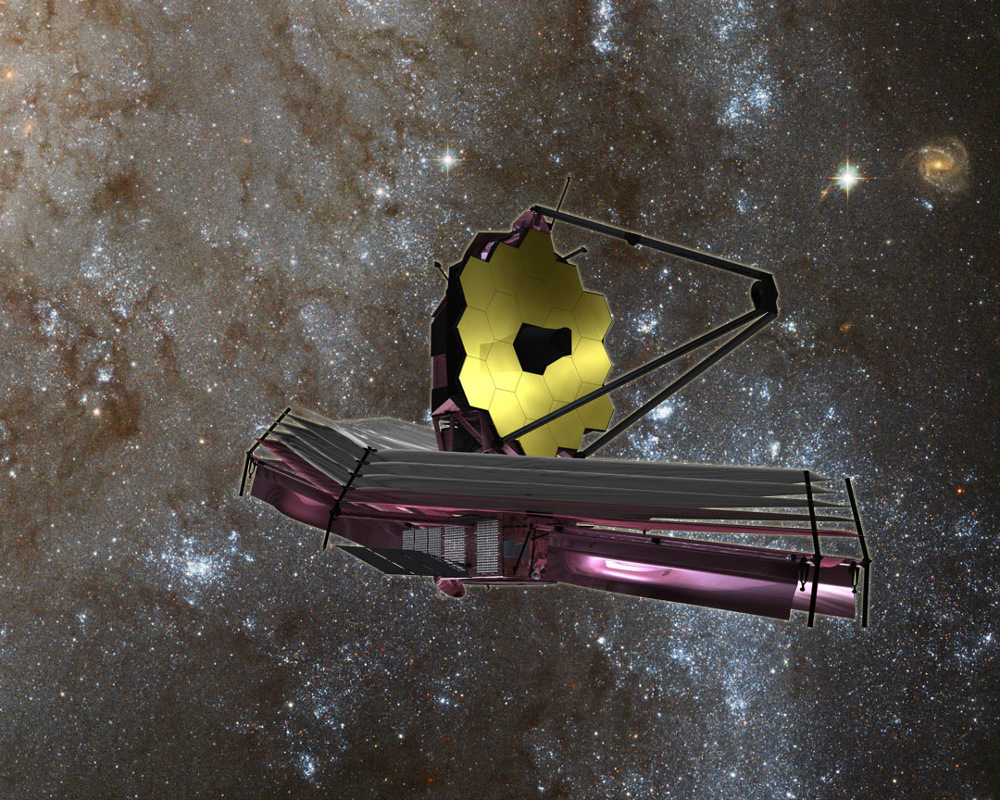
Artist’s concept of the James Webb Space Telescope (JWST) with Sunshield at bottom Credit: Ken Kremer.com
The James Webb Space Telescope web site
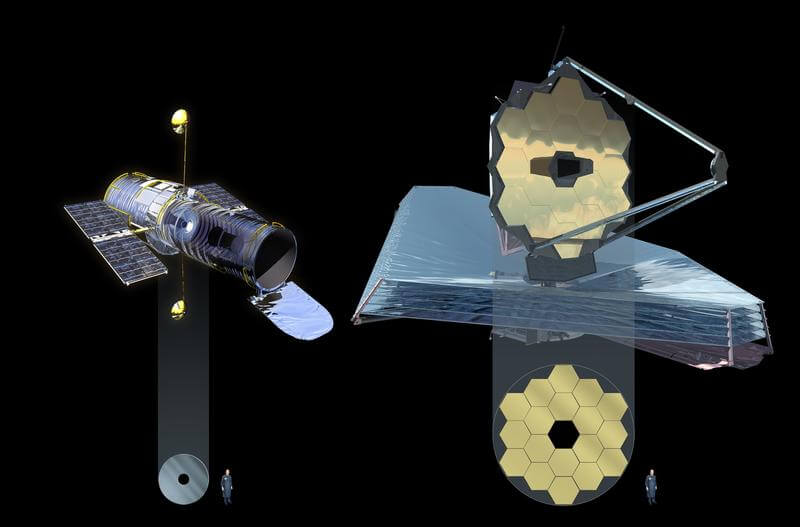
The Hubble Space Telescope on the left has a 2.4 meter mirror and the James Webb Space Telescope has a 6.5 meter mirror. LUVOIR, not shown, will dwarf them both with a massive 15 meter mirror. Credit: NASA
Published on Apr 17, 2017 Visit for more. Stringent testing is underway to prove the James Webb Space Telescope can handle an Earth-shaking take-off and still capture the universe’s first light while deeply ensconced in the hyper-cold of space.
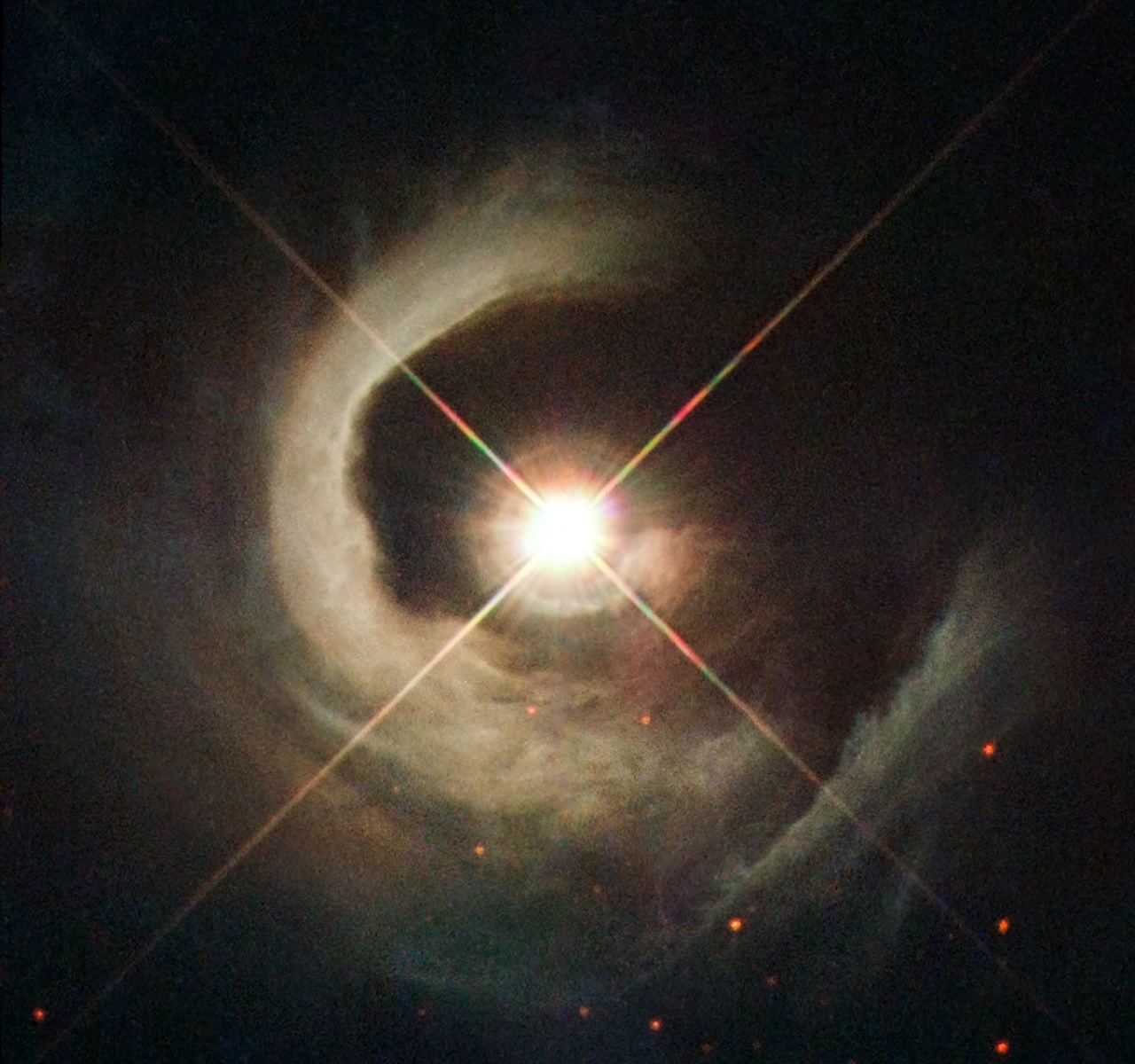
When it comes to the first galaxies, the James Webb Space Telescope will attempt to understand the formation of those galaxies and their link to the underlying dark matter. In case you didn’t know, most of the matter in our universe is invisible (a.k.a. “dark”), but its gravity binds everything together, including galaxies. So by studying galaxies – and especially their formation – we can get some hints as to how dark matter works. At least, that’s the hope. It turns out that astronomy is a little bit more complicated than that, and one of the major things we have to deal with when studying these distant galaxies is dust. A lot of dust.
Were the dark ages really dark? What is a perturbation, and how did they grow in the early universe? When the first stars awoke, what happened? I discuss these questions and more in today’s Ask a Spaceman! Full podcast episodes: Support the show: Follow: Follow: on twitter Follow:on Facebook Watch on YouTube: Go on an adventure: Keep those questions about space, science, astronomy, astrophysics, physics, and cosmology coming to #AskASpaceman for COMPLETE KNOWLEDGE OF TIME AND SPACE! Big thanks to my top Patreon supporters this month: Robert R., Justin G., Matthew K., Kevin O., Chris C., Helge B., Tim R., Steve P., Lars H., Khaled T., Chris L., John F., Craig B., Mark R., David B., Stephen M., Andrew P., and George L.! Music by Jason Grady and Nick Bain. Thanks to WCBE Radio for hosting the recording session, Greg Mobius for producing, and Cathy Rinella for editing. Hosted by Paul M. Sutter, astrophysicist at The Ohio State University, Chief Scientist at COSI Science Center, and the one and only Agent to the Stars
In this week's questions show, I wonder if the James Webb Space Telescope will be able to find satellites around other stars, what my favorite sci-fi FTL method is, and why can't we see Mars as a bright object in the sky? Check out Abby's channel here: Sign up to my weekly email newsletter: Support us at:Support us at: Follow us on Tumblr: More stories at Follow us on Twitter: @universetoday Like us on Facebook: Instagram - Team: Fraser Cain - @fcain / frasercain@gmail.com Karla Thompson - @karlaii Chad Weber - Chloe Cain - Instagram: @chloegwen2001 Music: Left Spine Down - “X-Ray”
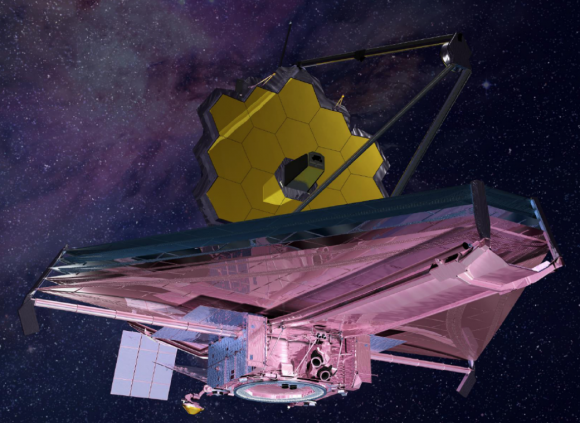
Illustration of NASA’s James Webb Space Telescope. Credits: NASA
A composite image from IllustrisTNG. Panels on the left show galaxy-galaxy interactions and the fine-grained structure of extended stellar halos. Panels on the right show stellar light projections from two massive central galaxies at the present day. It’s easy to see how the light from massive central galaxies overwhelms the light from stellar halos. Image: IllustrisTNG
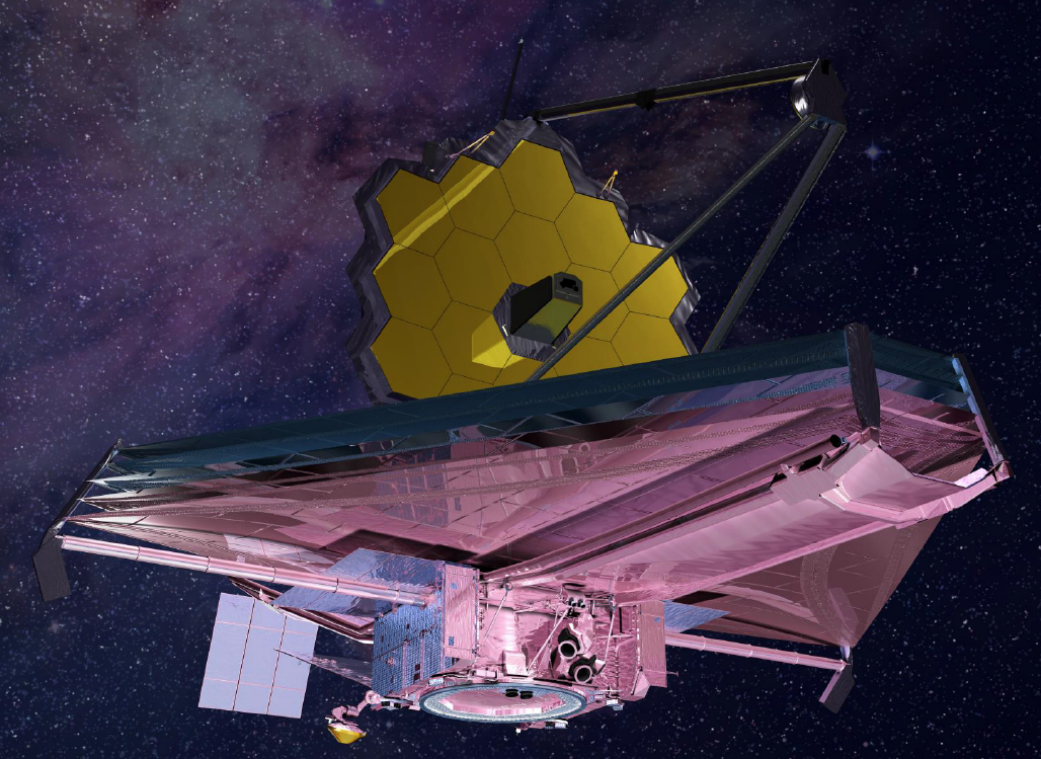
Once it is deployed to space, the James Webb Space Telescope (JWST) will be the most sophisticated and advanced space telescope in operation. Carrying on in the tradition of Hubble, Kepler, and Spitzer, the JWST will use its advanced suite of infrared imaging capabilities to study distant exoplanets, learn more about the Solar System, and study the earliest galaxies in the Universe.
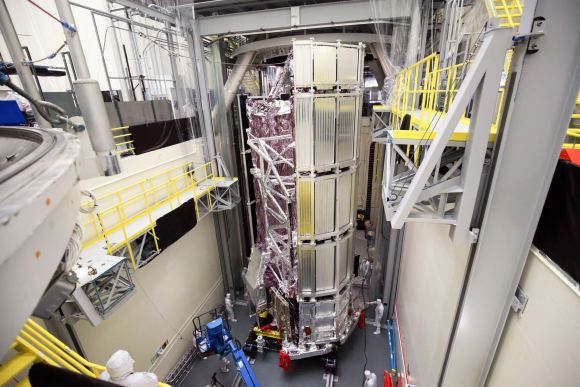
The James Webb’s spacecraft element being placed into Northrop Grumman’s environmental testing chambers. Credits: Northrop Grumman
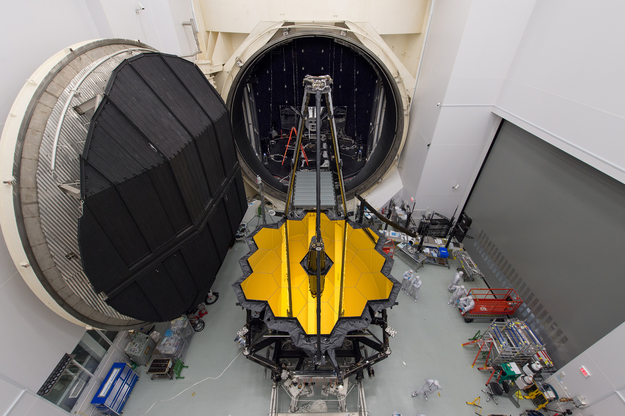
Testing Webb. Credit: NASA/Desiree Stover
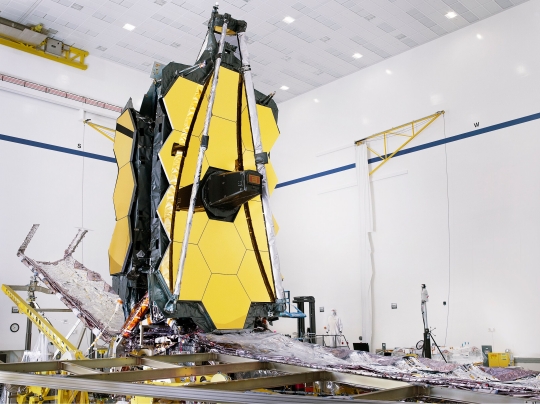
Image: The fully assembled James Webb Space Telescope with its sunshield and unitized pallet structures (UPSs) that fold up around the telescope for launch, are seen partially deployed to an open configuration to enable telescope installation. Credits: NASA/Chris Gunn. “This is an exciting time to now see all Webb’s parts finally joined together into a single observatory for the very first time,” says Gregory Robinson, the Webb program director at NASA Headquarters in Washington, D.C. “The engineering team has accomplished a huge step forward and soon we will be able to see incredible new views of our amazing universe.”
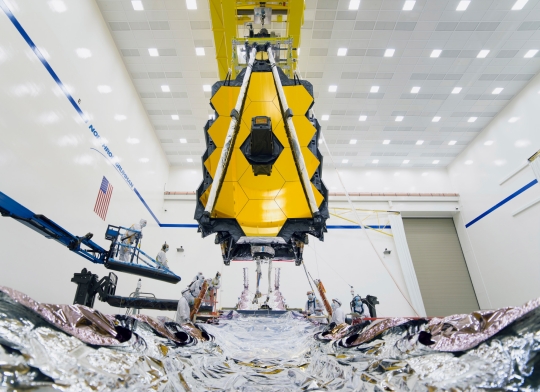
Image: Integration teams carefully guide Webb’s suspended telescope section into place above its Spacecraft Element just prior to integration. Credit: NASA/Chris Gunn. The sunshield should allow the telescope, once at the L2 Lagrangian point, to cool down below 50 Kelvin (-223 degrees Celsius) by simply radiating its heat into space. This will allow successful functioning of the near-infrared instruments, which include the Near Infrared Camera (NIRCam), the Near InfraRed Spectrograph (NIRSpec) and the Fine Guidance Sensor / Near Infrared Imager and Slitless Spectrograph (FGS/NIRISS) — all of these work at 39 K (-234°C). The Mid-Infrared Instrument (MIRI) will operate at 7 K (-266 degrees Celsius) using a cryocooler system. Thermal stability will allow proper alignment of the primary mirror segments.
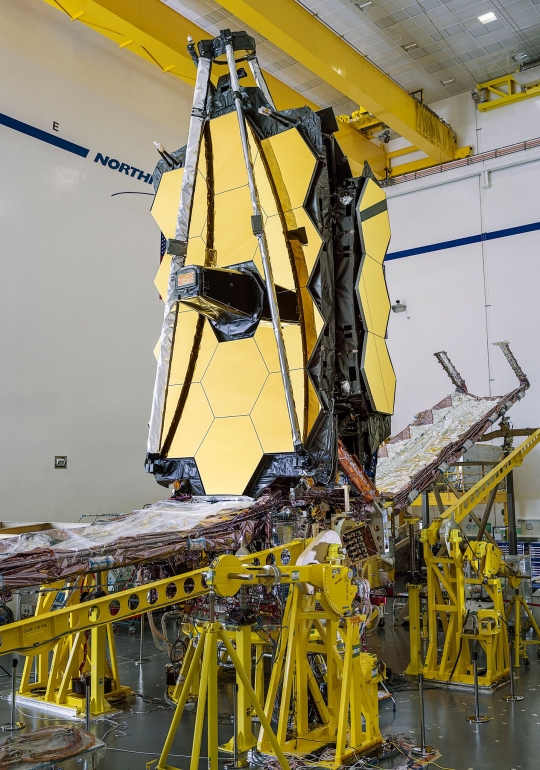
Image: NASA’s James Webb Space Telescope, post-integration, inside Northrop Grumman’s cleanroom facilities in Redondo Beach, California. Credit: NASA/Chris Gunn. With launch scheduled for 2021, extensive environmental and deployment testing will now be undertaken for the fully assembled observatory. All of the telescope’s major components have gone through rounds of environmental tests including launch stress and vibration, but we now have to put the integrated assembly through its paces. As if launch wasn’t stressful enough, we’ll have to sweat out deployment of the sunshield and the 6.5-meter primary mirror, all destined for Earth-Sun L2, which is far beyond the orbit of the Moon. Plenty of suspense ahead as we tune-up for 2021. Getting this expensive bird in place is going to be a nail-biter.
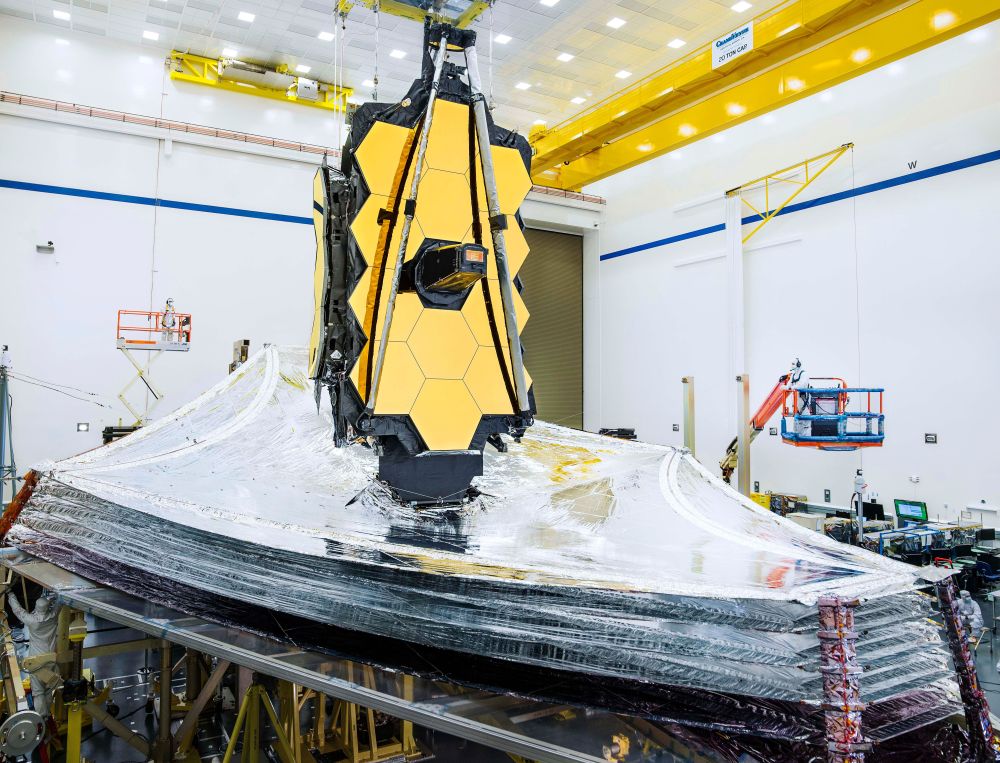
Put “James Webb Telescope launch” into your search engine and you’ll be flooded with links, some reaching back to the ‘scope’s first proposed launch date in 2010. The delayed launch of the space telescope is a running theme in the space community, even though we all know it’s going to be worth the wait. So nobody will be surprised by this latest development in the story of the world’s most anticipated telescope.

The sunshield of NASA’s James Webb Space Telescope sits deployed inside a cleanroom at Northrop Grumman Aerospace Systems in Redondo Beach, California, in October 2017. Credits: Northrop Grumman
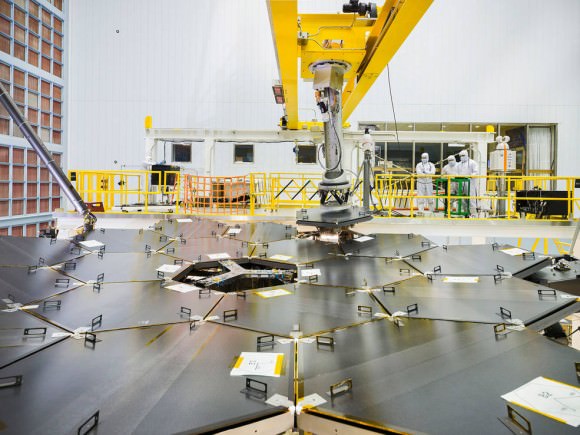
Inside a massive clean room at NASA’s Goddard Space Flight Center in Greenbelt, Maryland the James Webb Space Telescope team used a robotic am to install the last of the telescope’s 18 mirrors onto the telescope structure. Credits: NASA/Chris Gunn
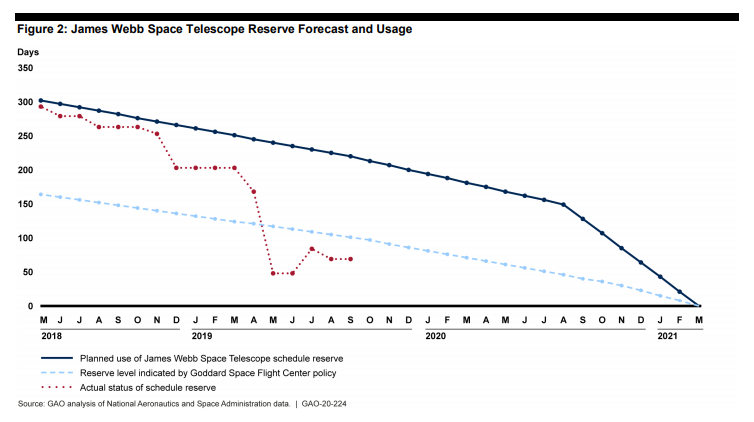
Problems with components of the data transmission system used up 75% of the project’s reserve time, putting even more pressure on the launch date. Image Credit: GAO/JWST Report
On March 30, 2021, NASA’s James Webb Space Telescope will blast off from the European Space Agency’s European spaceport in Kourou, French Giana on board an Ariane 5 rocket. It’ll fly to the Sun-Earth L2 Lagrange point, a relatively stable spot in space that keeps the glare from the Sun, Earth, and Moon all in a tiny spot in the sky. Then, it’ll unfurl its tennis court-sized sunshade, fold out its gigantic 6.5-meter mirror, and peer out into the distant cosmos. Over the course of the next 10 years, this infrared observatory will help astronomers learn about the earliest moments of the Universe, directly observe the atmospheres of planets orbiting other stars, and peer at newly forming stars and planets. And if you listened to the words I just said with equal parts terror and skepticism, I don’t blame you. James Webb’s path to space has been long and tortuous. And the risks that the mission still faces are very real. Hopefully, the science will be worth it. Hopefully, nothing else goes wrong from now until deployment. So today, I want to do a deep dive into James Webb. To talk about the history of the mission, why it exists, how the development went, and where it stands today. I’ll warn you though, the length of this video is going to go way over budget. Our Book is out! Audio Podcast version: ITunes: RSS: RSS: Sign up to my weekly email newsletter: Support us at:Support us at: Follow us on Tumblr: : More stories at Follow us on Twitter: @universetoday Like us on Facebook: Instagram - Team: Fraser Cain - @fcain / frasercain@gmail.com /Karla Thompson - @karlaii Chad Weber - Chloe Cain - Instagram: @chloegwen2001 References: Planning for JWST About - Hubble Servicing Missions Discoveries | Highlights of Hubble’s Exploration of the Universe THE NEXT GENERATION SPACE TELESCOPE (pdf) A Balance Between Human Space Flight And Science Design Reference Mission TRW Selected as JWST Prime Contractor NASA Announces Contract For Next Generation Space Telescope, Named After Space Pioneer News Feature Published: 27 October 2010 Space science: The telescope that ate astronomy IPAC near mid and far infrared OBSERVATORY INSTRUMENTS Sunshield The ISIM houses the four main instruments that will detect light from distant stars and galaxies, and planets orbiting other stars. NIRCam will detect light from: the earliest stars and galaxies in the process of formation, the population of stars in nearby galaxies, as well as young stars in the Milky Way and Kuiper Belt objects. FGS is a "guider," which helps point the telescope. NIRISS will be used to investigate the following science objectives: first light detection, exoplanet detection and characterization, and exoplanet transit spectroscopy. Webb vs Hubble Telescope Webb vs Hubble Telescope General Questions about Webb Jet Propulsion lab spitzer telescope Technical FAQ On A Variety Of Mission Issues, Aspects And Capabilities. ( FOR THE SCIENCE/TECHNICAL COMMUNITY.) NASA Completes Webb Telescope Review, Commits to Launch in Early 2021 NASA’s James Webb Space Telescope Has Been Assembled for the First Time
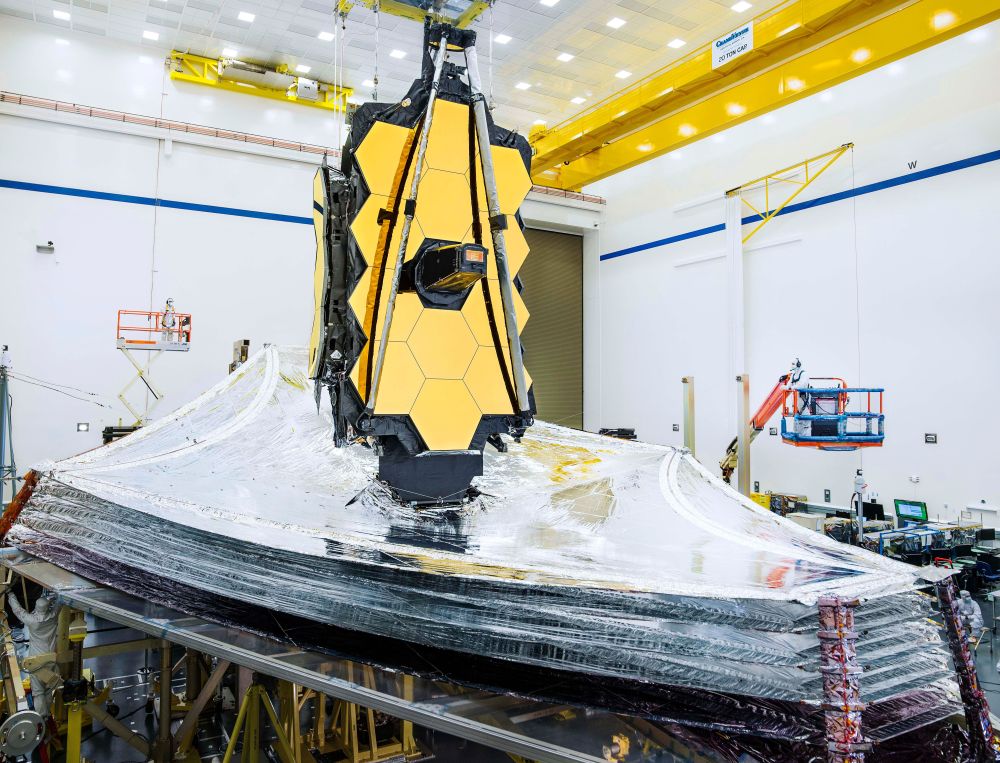
During a recent test, engineers and technicians fully deployed all five layers of the James Webb Space Telescopes sun-shield. Image Credit: NASA/Chris Gunn
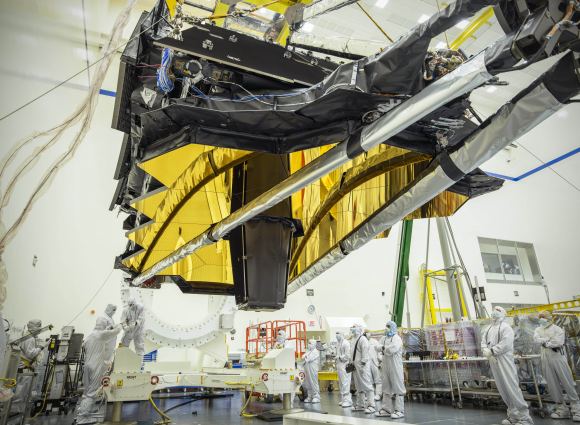
The sunshield of NASA’s James Webb Space Telescope sits deployed inside a cleanroom at Northrop Grumman Aerospace Systems in Redondo Beach, California, in October 2017. Credits: Northrop Grumman
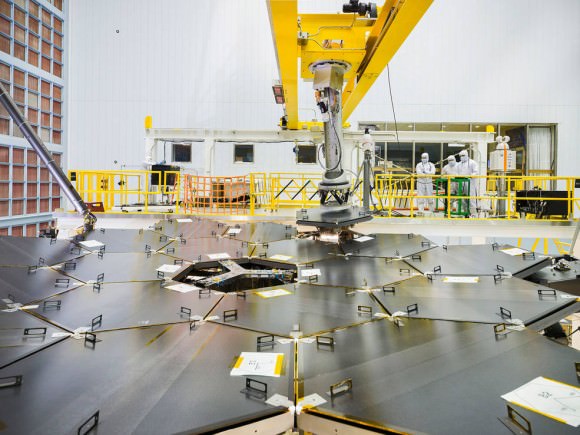
Inside a massive clean room at NASA’s Goddard Space Flight Center in Greenbelt, Maryland the James Webb Space Telescope team used a robotic am to install the last of the telescope’s 18 mirrors onto the telescope structure. Credits: NASA/Chris Gunn
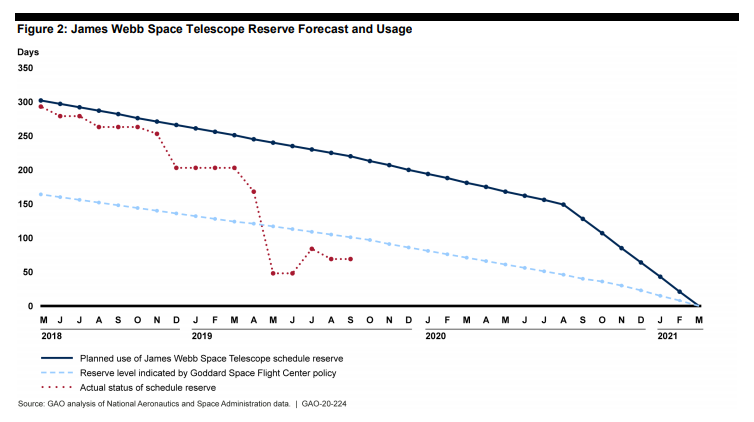
Problems with components of the data transmission system used up 75% of the project’s reserve time, putting even more pressure on the launch date. Image Credit: GAO/JWST Repor
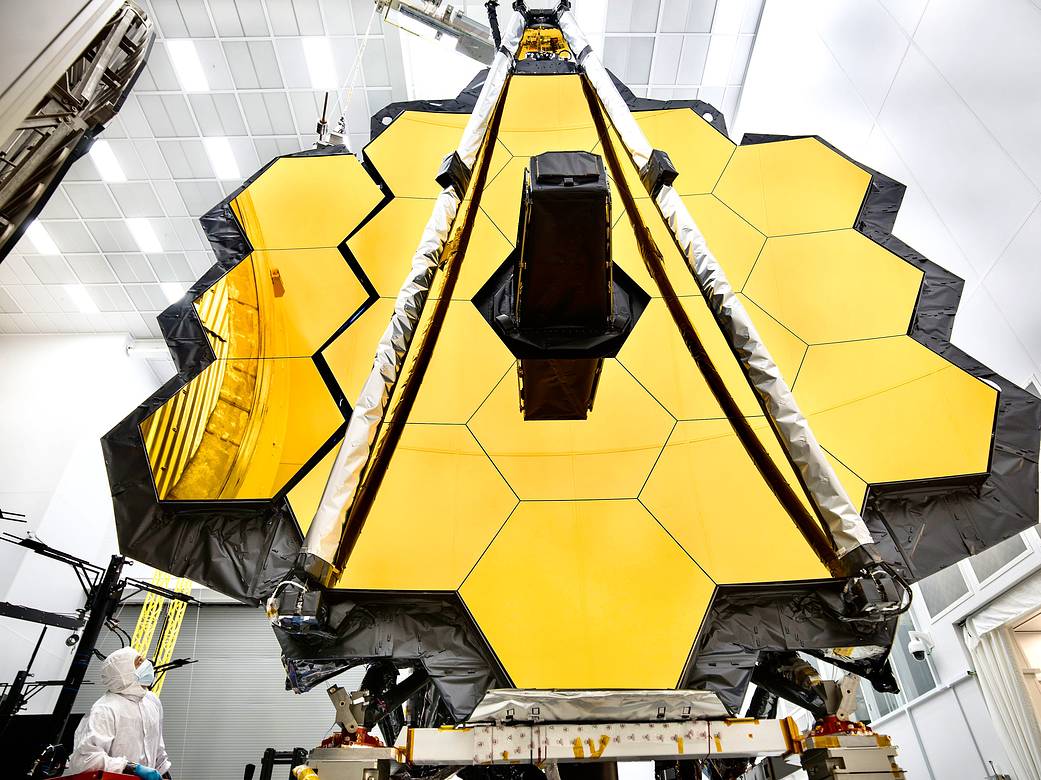
We’re inching closer and closer to the James Webb Space Telescope’s (JWST) launch date of March 30th, 2021, (or maybe July 2021.) We never thought we’d get this close, with only a year to go before we send this powerful space telescope on its way. Now the telescope has been put in its launch configuration.

For NASA’s James Webb Space Telescope to fit into an Ariane V rocket for launch, it must fold up. This graphic shows how Webb fits into the rocket fairing with little room to spare. Credits: ArianeSpace.com
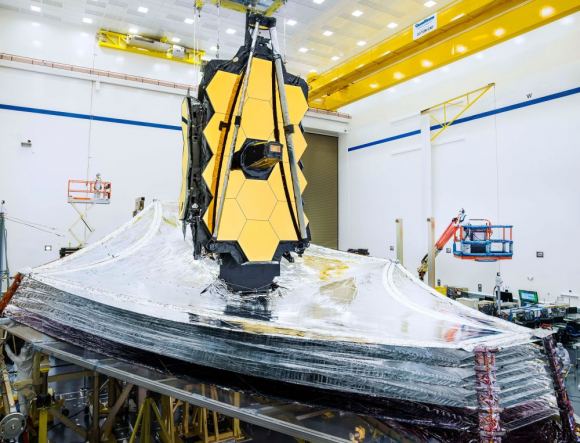
During a recent test, engineers and technicians fully deployed all five layers of the James Webb Space Telescopes sun-shield. Image Credit: NASA/Chris Gunn
This video shows how NASA’s James Webb Space Telescope is designed to fold to a much smaller size in order to fit inside the Ariane V rocket for launch to space. The largest, most complex space observatory ever built, must fold itself to fit within a 17.8-foot (5.4-meter) payload fairing, and survive the rigors of a rocket ride to orbit. After liftoff, the entire observatory will unfold in a carefully choreographed series of steps before beginning to make groundbreaking observations of the cosmos. : Read more Credit: NASA's Goddard Space Flight Center If you liked this video, subscribe to the NASA Goddard YouTube channel: Follow NASA’s Goddard Space Flight Center · Instagram · Twitter NASA GODDARD · Twitter NASA GODDARD PICTURES · Facebook: · Flickr

The JWST will do its observing while in what’s called a halo orbit at the Sun-Earth LaGrangian 2 point, a gravitationally stable point 1.5 million km from Earth. Image: NASA/JWST
On March 30, 2021, NASA’s James Webb Space Telescope will blast off from the European Space Agency’s European spaceport in Kourou, French Giana on board an Ariane 5 rocket. It’ll fly to the Sun-Earth L2 Lagrange point, a relatively stable spot in space that keeps the glare from the Sun, Earth, and Moon all in a tiny spot in the sky. Then, it’ll unfurl its tennis court-sized sunshade, fold out its gigantic 6.5-meter mirror, and peer out into the distant cosmos. Over the course of the next 10 years, this infrared observatory will help astronomers learn about the earliest moments of the Universe, directly observe the atmospheres of planets orbiting other stars, and peer at newly forming stars and planets. And if you listened to the words I just said with equal parts terror and skepticism, I don’t blame you. James Webb’s path to space has been long and tortuous. And the risks that the mission still faces are very real. Hopefully, the science will be worth it. Hopefully, nothing else goes wrong from now until deployment. So today, I want to do a deep dive into James Webb. To talk about the history of the mission, why it exists, how the development went, and where it stands today. I’ll warn you though, the length of this video is going to go way over budget. Our Book is out! Audio Podcast version: ITunes: RSS: Sign up to my weekly email newsletter: Support us at:Support us at: Follow us on Tumblr: : More stories at Follow us on Twitter: @universetoday Like us on Facebook: Instagram - Team: Fraser Cain - @fcain / frasercain@gmail.com /Karla Thompson - @karlaii Chad Weber - Chloe Cain - Instagram: @chloegwen2001 References: Planning for JWST About - Hubble Servicing Missions Discoveries | Highlights of Hubble’s Exploration of the Universe THE NEXT GENERATION SPACE TELESCOPE initial report on JWST (pdf) Who is James Webb? Design Reference Mission TRW Selected as JWST Prime Contractor NASA Announces Contract For Next Generation Space Telescope,Named After Space Pioneer Space science: The telescope that ate astronomy from Nature magazine Near, Mid and Far Infrared JWST SUNSHIELD ISM & INSTRUMENTS ISM & NIRCAM FGS/NIRISS MIRI WEBB VS HUBBLE Frequently Asked Questions Spitzer cal tech page Technical FAQ On A Variety Of Mission Issues, Aspects And Capabilities. NASA Completes Webb Telescope Review, Commits to Launch in Early 2021 NASA’s James Webb Space Telescope Has Been Assembled for the First Time
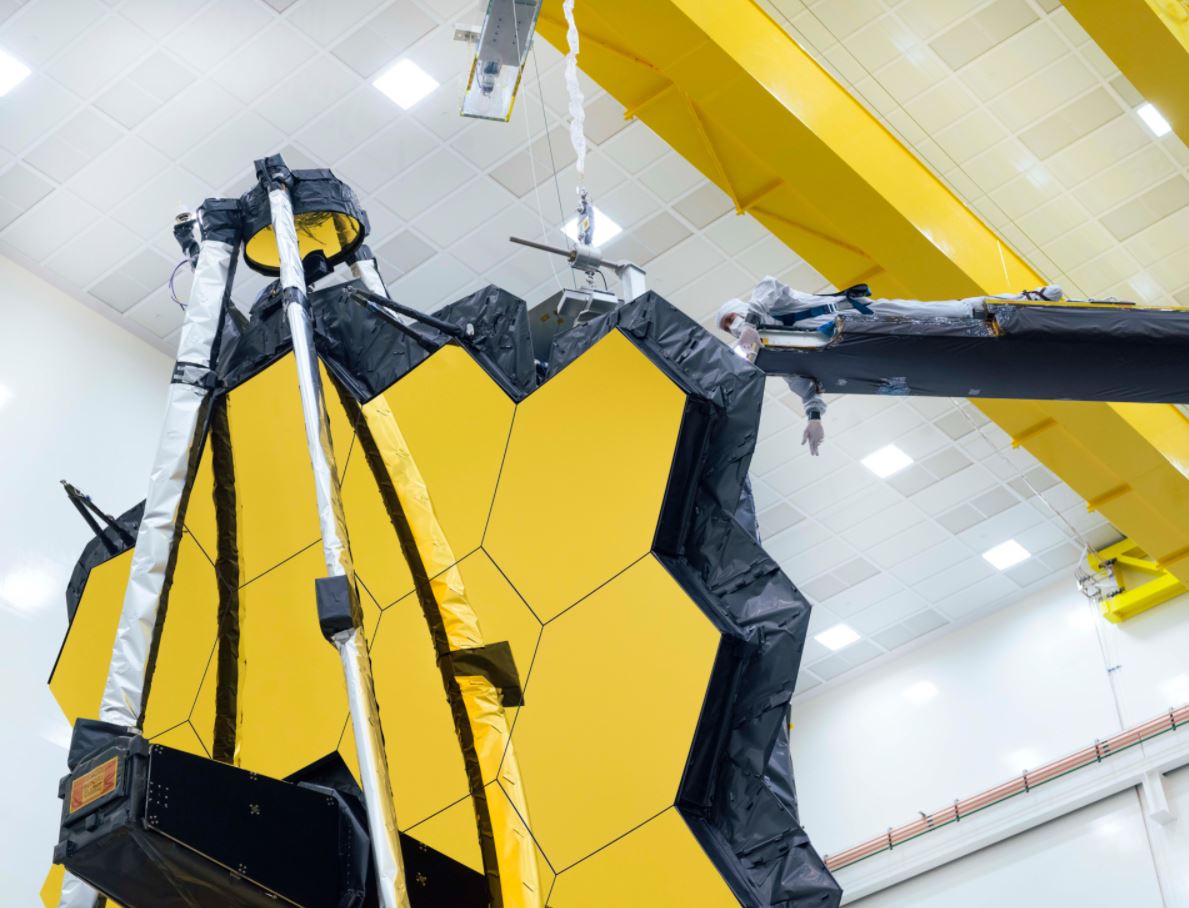
The process of deploying, moving, expanding and unfurling all of Webb’s many movable pieces after they have been exposed to a simulated launch is the best way to ensure they will perform as intended once in space. Credits: NASA/Chris Gunn
This video shows the James Webb Space Telescope's mirrors during their long string of tests, from individual segments to the final tests of the assembled mirror. :Learn more about the journey of the mirrors here Read more about our latest milestone, the mirrors last unfolding on Earth. The next time will be in space! : Download this video plus additional B-roll Credits: NASA's Goddard Space Flight Center Michael P. Menzel (AIMM): Producer Michael McClare (KBRwyle): Lead Videographer Sophia Roberts (AIMM): Videographer Michael P. Menzel (AIMM): Video Editor Music credit: Encrypted(C)2017, Atmosphere Music Ltd. [ PRS ], Steve Everitt
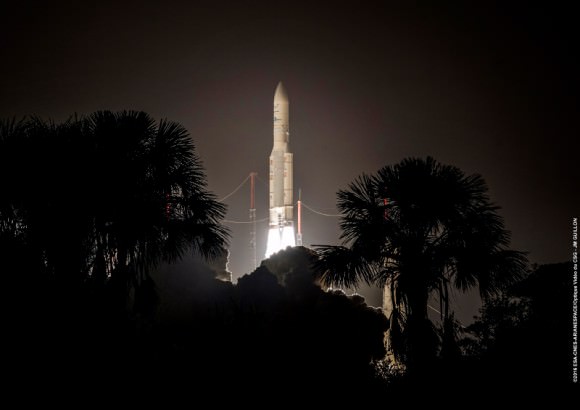
The Ariane5 lifting off from Kourou in French Guiana. Image: ESA/Arianespace.
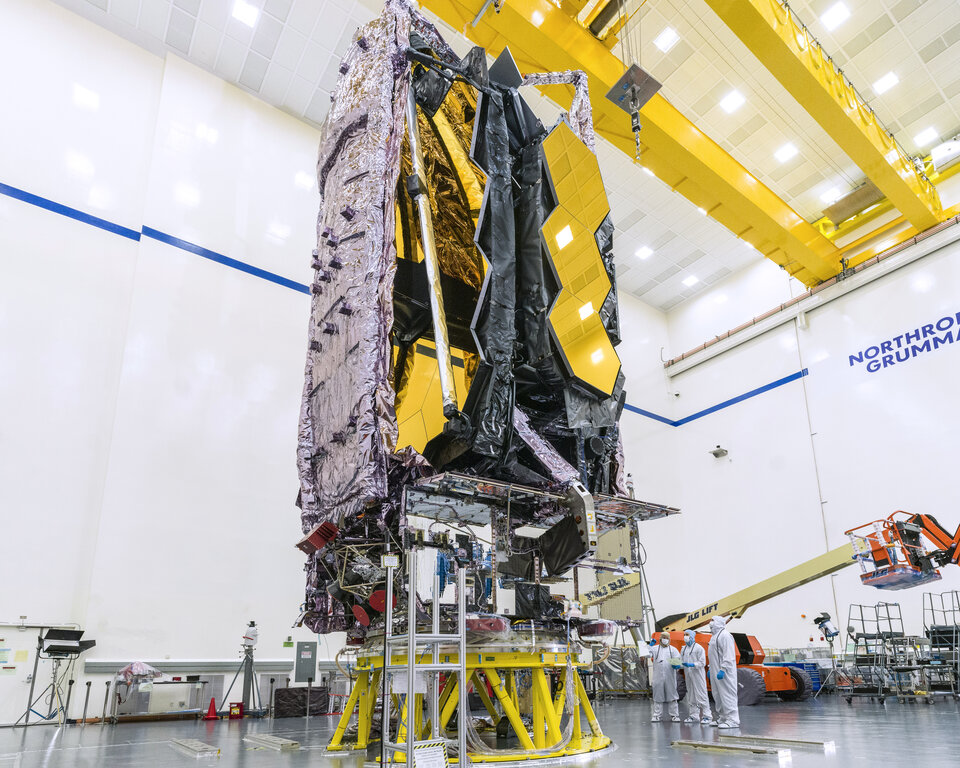
With integration and testing formally concluded for the James Webb Space Telescope, NASA’s next giant leap into the cosmic unknown will soon be underway. Credits: NASA/Chris Gunn
Engineering teams have completed the James Webb Space Telescope’s long-spanning comprehensive testing regimen at Northrop Grumman’s facilities. Webb’s many tests and checkpoints were designed to ensure that the world’s most complex space science observatory will operate as designed once in space. Now that observatory testing has concluded, shipment operations have begun. This includes all the necessary steps to prepare Webb for a safe journey through the Panama Canal to its launch location in Kourou, French Guiana, on the northeastern coast of South America. Read more: Download this video: Credits: NASA's Goddard Space Flight Center Music Credit: Interstellar Travels, Copyright, 2012, Soundcast Music [SESAC], Christian Telford, David Travis Edwards, Matthew St Laurent, Robert Anthony Navarro Michael P. Menzel (AIMM): Lead Producer Thaddeus Cesari (X3M Systems): Writer Aaron E. Lepsch (ADNET): Technical Support Sophia Roberts (AIMM): Videographer Michael P. Menzel (AIMM): Lead Videographer Michael P. Menzel (AIMM): Video Editor
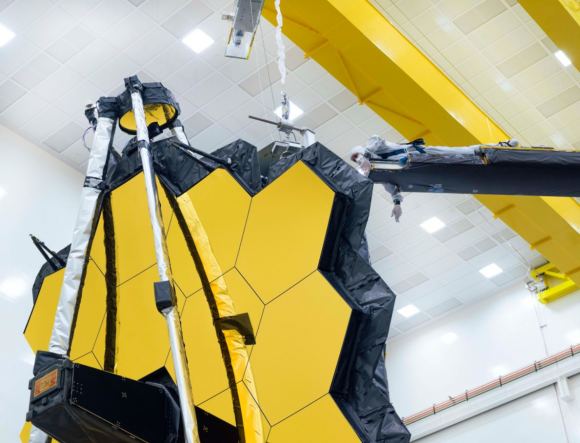
The conclusion of this test represents the team’s final in a long series of checkpoints designed to ensure Webb’s 18 hexagonal mirrors are prepared for a long life of profound discovery. Credits: NASA/Chris Gunn

Webb launch timeline at Europe’s Spaceport. Credit: ESA.

Whew! A major milestone was achieved today in the James Webb Space Telescope’s journey towards launch. After the telescope successfully arrived in French Guiana yesterday following a secretive 16-day ocean journey (with apparently no pirates in sight), today the telescope took a short road trip over land to the ESA’s spaceport in Kourou. JWST is now at the payload processing facility, where staff will start the process of getting the telescope into the Ariane 5 rocket fairing. Launch is currently scheduled for December 18, 2021 …
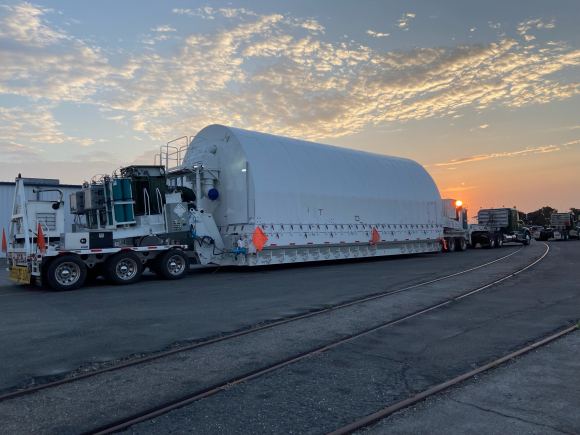
JWST inside the specialized, airtight shipping container. Image courtesy Rohde and Liesenfeld.
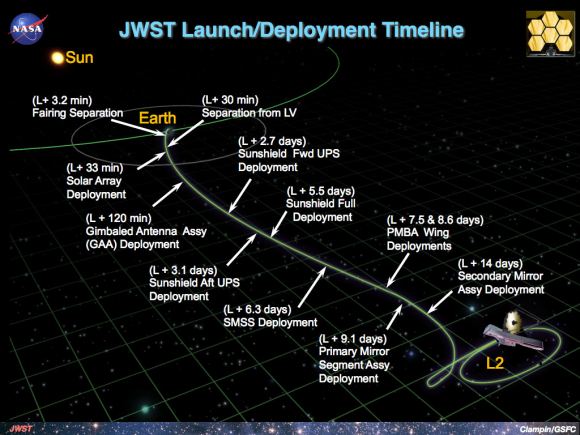
WST’s deployment timeline. Credit: ESA
The NIRSpec instrument is the workhorse near-infrared spectrograph on board the James Webb Space Telescope and is provided by ESA. The primary goal of NIRSpec is to enable large spectroscopic surveys of astronomical objects such as stars or distant galaxies. This is made possible by its powerful multi-object spectroscopy mode, which makes use of microshutters. This mode is capable of obtaining spectra of up to nearly 200 objects simultaneously, over a 3.6×3.4 arcminute field of view – the first time this capability has been provided from space. This mode makes for very efficient use of Webb’s valuable observing time. This animation shows the path followed by light from an astronomical object as it travels through the NIRSpec components and onto the detector. Learn more about spectroscopy with the Webb telescope: : Learn more about Webb ★ Subscribe:and click twice on the bell button to receive our notifications. Check out our full video catalog: Follow us on Twitter: On Facebook: On Instagram: On Pinterest: On Flickr: We are Europe's gateway to space. Our mission is to shape the development of Europe's space capability and ensure that investment in space continues to deliver benefits to the citizens of Europe and the world. Check out to get up to speed on everything space related. Copyright information about our videos is available here: #ESA #Webb #WebbSeesFarther Music in this video Learn more Listen ad-free with YouTube Premium Song Six Seasons Artist Unicorn Heads Album Six Seasons Licensed to YouTube by YouTube Audio Library (on behalf of YouTube Audio Library); BMI - Broadcast Music Inc.

On Oct. 12th 2021, the James Webb Space Telescope (JWST) arrived safely at Port de Pariacabo in French Guiana after spending 16 days traveling between California and South America. Since then, the observatory was transported from California to French Guiana and brought to a cleanroom in the Guyanese Space Center (GSC). Here, crews “unboxed” the observatory from its protective cargo container in preparation for launch – now targetted for Dec. 18th 2021.
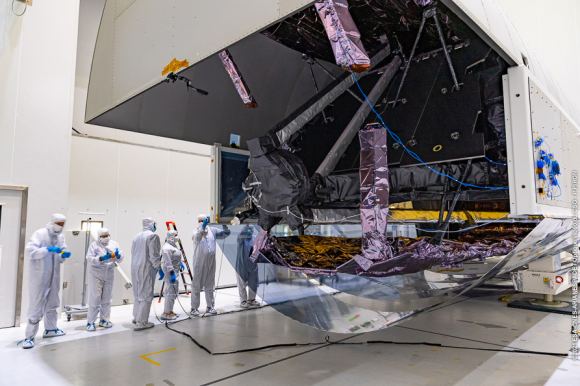
The JWST being removed from its protective container. Credit: ESA/CNES/Arianespace
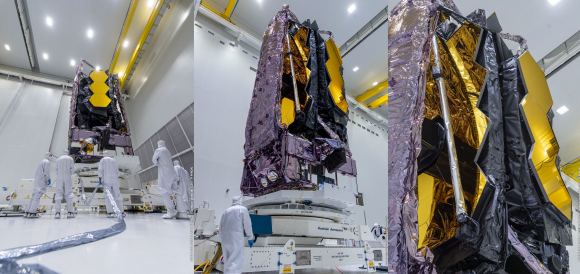
The JWST being removed from its protective container. Credit: ESA/CNES/Arianespace
The greatest origin story of all unfolds with the James Webb Space Telescope. Webb's launch is a pivotal moment that exemplifies the dedication, innovation, and ambition behind NASA and its partners, the European Space Agency (ESA) and Canadian Space Agency (CSA), but it is only the beginning. The 29 days following liftoff will be an exciting but harrowing time. Thousands of parts must work correctly, in sequence, to unfold Webb and put it in its final configuration, all while it flies through the expanse of space alone, to a destination nearly one million miles away. As the largest and most complex telescope ever sent into space, the James Webb Space Telescope is a technological marvel. By necessity, Webb takes on-orbit deployments to the extreme. Each step can be controlled expertly from the ground, giving Webb’s Mission Operations Center full control to circumnavigate any unforeseen issues with deployment. Credit: NASA Goddard Space Flight Center Michael McClare (KBRwyle): Producer Michael McClare (KBRwyle): Director Michael McClare (KBRwyle): Writer Michael McClare (KBRwyle): Video Editor Aaron E. Lepsch (ADNET): Technical Support Download this video:
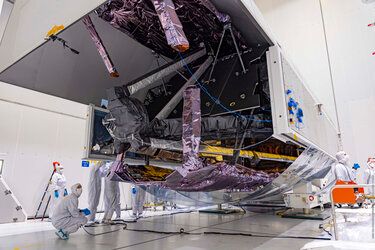
Part of the JWST unboxing in ESA’s Spaceport’s cleanroom Credit – ESA
After its arrival at Pariacabo harbour in French Guiana on 12 October 2021, the James Webb Space Telescope was transported to Europe’s Spaceport and unboxed in the cleanroom. It is now being prepared for its launch on an Ariane 5 rocket in December. Though the telescope weighs only six tonnes, it is more than 10.5 m high and almost 4.5 m wide when folded. It was shipped in its folded position in a 30 m long container which, with auxiliary equipment, weighed more than 70 tonnes. After arriving in the harbour, the telescope inside its container was towed by a heavy-load tractor unit to the spacecraft processing facility at Europe’s Spaceport. There, Webb’s special shipping container was opened, and the telescope was unboxed inside the facility’s cleanroom and installed on a rollover fixture to raise it vertical. This is how it will stand inside the Ariane 5 fairing. Webb’s launch campaign involves more than 100 specialists. Teams will work separately to prepare the telescope and the launch vehicle until they become one combined team to join the telescope with its rocket for a momentous liftoff. Webb will be the largest, most powerful telescope ever launched into space. As part of an international collaboration agreement, ESA is providing the telescope’s launch service using the Ariane 5 launch vehicle. Working with partners, ESA was responsible for the development and qualification of Ariane 5 adaptations for the Webb mission and for the procurement of the launch service by @arianespace. Webb is an international partnership between @NASA, ESA and the @Canadian Space Agency. Find out more about Webb in ESA’s launch kit: Credit: ESA/@CNES/Arianespace/@NASA GoddardSpace Flight Center ★ Subscribe:and click twice on the bell button to receive our notifications. Check out our full video catalog: Follow us on Twitter: On Facebook: On Instagram: On Flickr: We are Europe's gateway to space. Our mission is to shape the development of Europe's space capability and ensure that investment in space continues to deliver benefits to the citizens of Europe and the world. Check out to get up to speed on everything space related. Copyright information about our videos is available here:
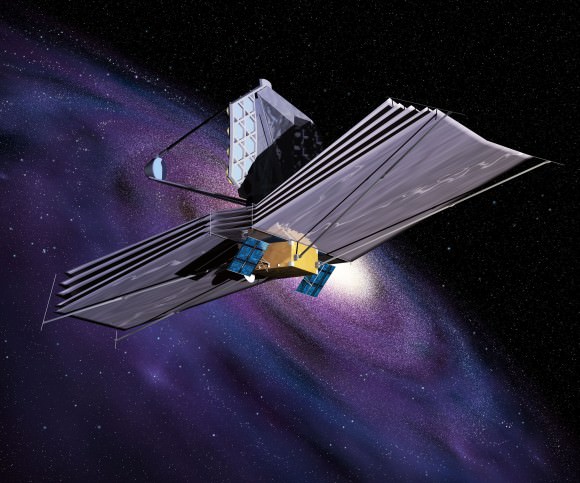
n Artist’s Conception of the James Webb Space Telescope in space. Credit: ESA.
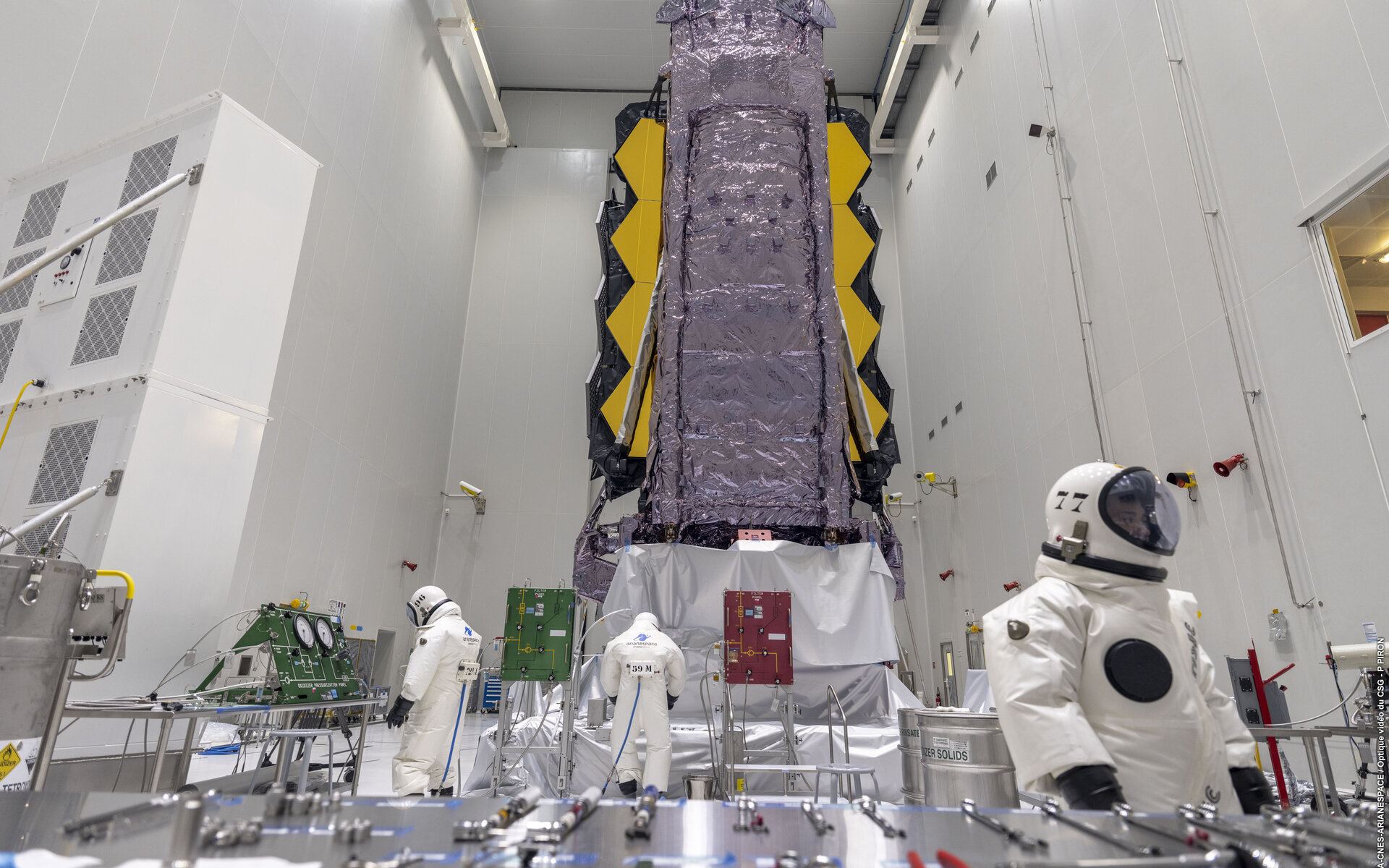
On Oct. 12th, 2021, after years of waiting and cost overruns, the James Webb Space Telescope (JWST) finally arrived safely at Europe’s Spaceport in Kourou, French Guiana. The crews began unboxing the next-generation observatory and getting it ready for integration with the Ariane 5 rocket that will take it to space. Then, an “incident” occurred where a clamp band suddenly released, sending vibrations throughout the facility. Once again, the JWST’s launch date was pushed back while crews investigated the source of the problem.
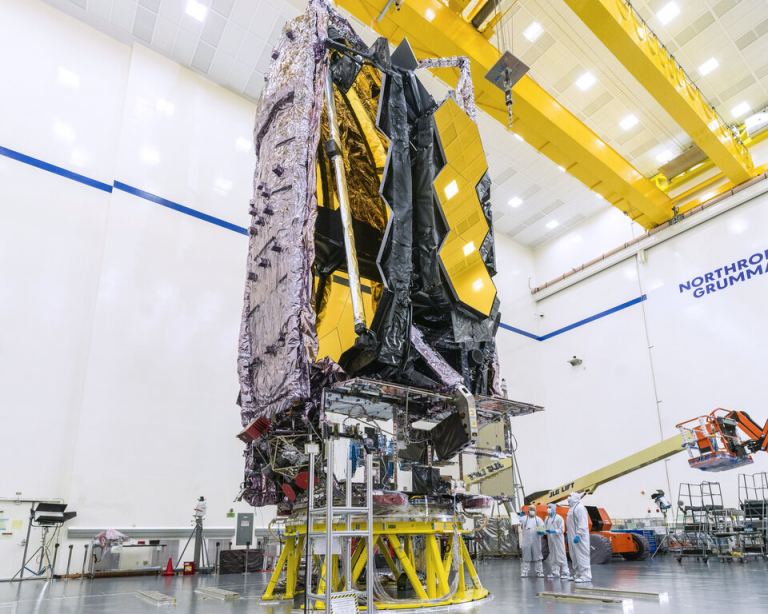
With integration and testing formally concluded for the James Webb Space Telescope, NASA’s next giant leap into the cosmic unknown will soon be underway. Credits: NASA/Chris Gunn
The world’s next generation cosmic observatory, the James Webb Space Telescope, is due for launch on an Ariane 5 from Europe’s Spaceport in French Guiana in late December. Developed and constructed over more than 30 years, Webb is a remarkable feat of engineering and technology – with the largest astronomical mirror ever flown in space, sophisticated new scientific instruments, and a sunshield the size of a tennis court. Webb is an international partnership between @NASA, ESA and the @Canadian Space Agency and will reveal the Universe in a whole new light. Optimised for infrared wavelengths, its detectors will be able to look back to shortly after the very dawn of time, revealing the formation of the first galaxies, as well as study stars and planets in our own Milky Way. Find out more about Webb in ESA’s launch kit: : ★ Subscribeand click twice on the bell button to receive our notifications. Check out our full video catalog: Follow us on Twitter: On Facebook: On Instagram: On Flickr: We are Europe's gateway to space. Our mission is to shape the development of Europe's space capability and ensure that investment in space continues to deliver benefits to the citizens of Europe and the world. Check out to get up to speed on everything space related. Copyright information about our videos is available here:
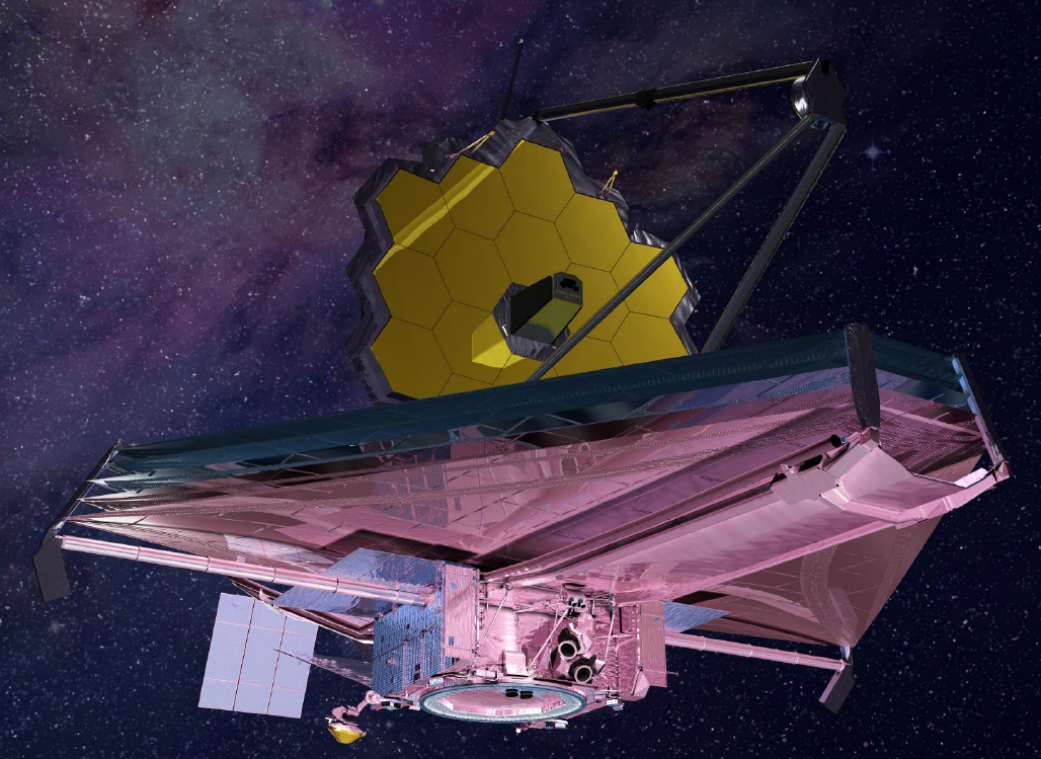
Lead image caption: Illustration of NASA’s James Webb Space Telescope. Credits: NASA

On December 17,2021 the Ariane 5 rocket fairing was closed around the James Webb Space Telescope. This protective fairing, or ‘nose cone’, will shield the telescope during liftoff and its journey through the atmosphere on December 24, 2021 Credit: ESA
n Friday 17 December 2021, the Ariane 5 rocket fairing was closed around the James Webb Space Telescope. This protective fairing, or ‘nose cone’, will shield the telescope during liftoff and its journey through the atmosphere on 24 December. Earlier, Webb was placed on top of Ariane 5 and a protective ‘shower curtain’ was put up to avoid any contamination. On the day of encapsulation in the fairing, a protective cover on top of Webb was removed and the fairing was lowered down over the observatory and locked in place for liftoff. This was a particularly delicate operation, assisted by a laser guiding system, because the margins between the folded up observatory (4.5 m wide) and the rocket fairing (5.4 m wide) are small. The fairing is equipped with specialised environmental controls that keep the observatory in a perfectly controlled temperature and humidity range during its final few days on Earth. Now that Webb has been securely attached to its Ariane 5 launch vehicle, and enclosed within its protective fairing, mechanical operations involving the observatory at its launch site in French Guiana have formally concluded. Final electrical and software configurations will occur on the launch pad during the final hours before liftoff. Webb will switch to internal battery power roughly 20 minutes prior to liftoff, and within 15 minutes prior the observatory and its launch vehicle will both be fully cleared for flight. Ariane 5’s rollout to the launch pad is scheduled to begin Wednesday 22 December 2021, and this is where final health checks and preparations for liftoff will occur. Webb will be the largest, most powerful telescope ever launched into space. As part of an international collaboration agreement, ESA is providing the telescope’s launch service using the Ariane 5 launch vehicle. Working with partners, ESA was responsible for the development and qualification of Ariane 5 adaptations for the Webb mission and for the procurement of the launch service by @arianespace. Webb is an international partnership between @NASA, ESA and the @Canadian Space Agency. Find out more about Webb in ESA’s launch kit: ★ Subscribe:and click twice on the bell button to receive our notifications. Check out our full video catalog: Follow us on Twitter: On Facebook: On Instagram: On Flickr: We are Europe's gateway to space. Our mission is to shape the development of Europe's space capability and ensure that investment in space continues to deliver benefits to the citizens of Europe and the world. Check out to get up to speed on everything space related. Copyright information about our videos is available here: #ESA #Webb #WebbFliesAriane
after a detailed analysis of where the James Webb Space Telescope is now (Dec. 29, 2021) and how it got there, NASA determined the observatory should have enough propellant to operate in space for significantly more than 10 years in space. Webb’s mission lifetime was designed to be at least 5-1/2 years, and mission engineers and scientists were hoping for closer to 10 years.
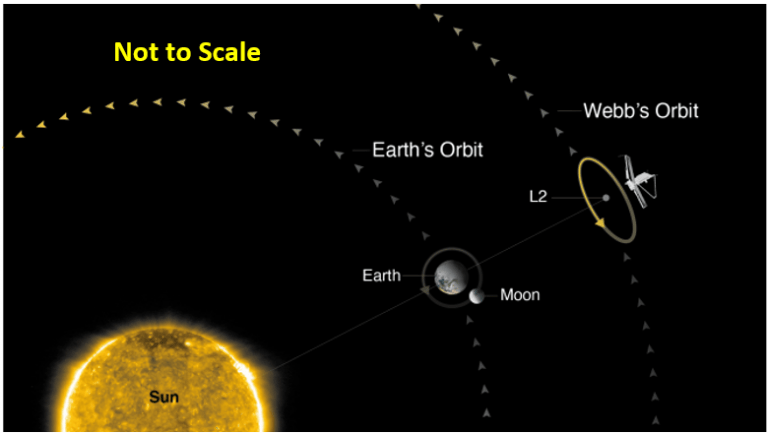
Webb’s orbit is around L2—a point of gravitational balance on the other side of Earth from the Sun—but it does not reside exactly at the L2 point. Right at that point, Earth’s shadowing of the Sun would be large enough to greatly reduce the amount of power available for Webb’s solar arrays, without greatly simplifying the cooling challenges. In addition, when Webb’s communication antennas point at Earth to receive commands, they would be blinded by the huge radio emission of the Sun in the same direction. Instead, as the diagram indicates, Webb operates in a very loose orbit (many hundreds of thousands of km in diameter) around L2, in constant sunlight and with clean communications with the ground stations. Credit: NASA
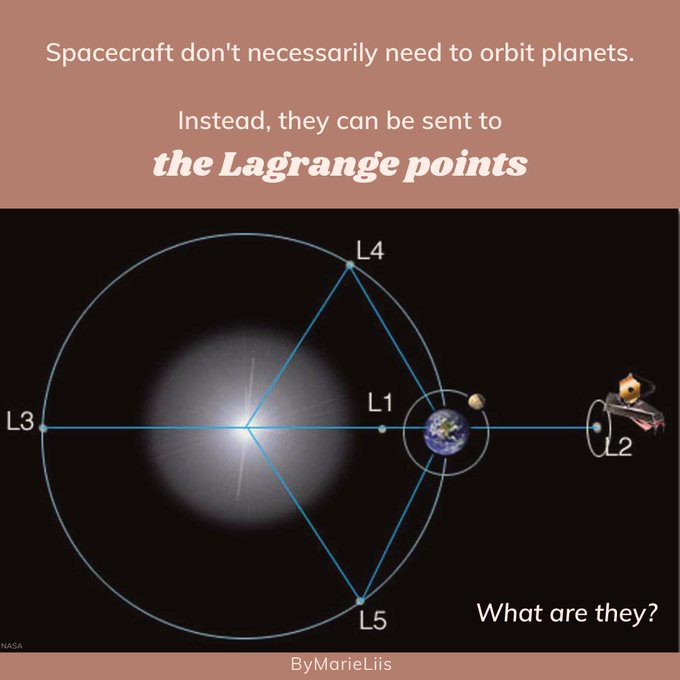
see the wikipedia article on lagrange points below
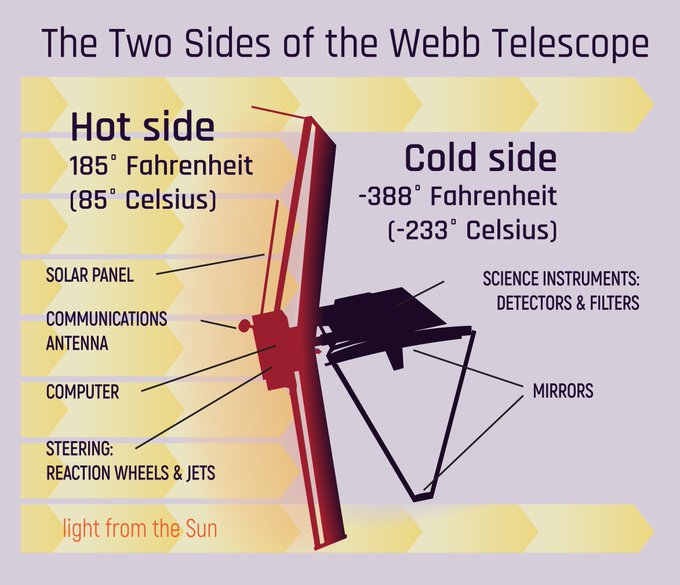
You’re hot and you’re cold… 🎵 The JWST is split into a “hot side” and “cold side” by its sunshield. The sunshield will always be facing the Sun to block out heat and light, as Webb's mirrors need to stay extremely cold to observe faint heat signals in the universe!
It’s really happening. The James Webb Space Telescope has successfully reached its orbital destination in space, 1.5 million km (1 million miles) from Earth. A final 5-minute thruster firing on January 24, 2022 put JWST in its halo orbit at the Sun-Earth Lagrange 2 (L2) point. The formal commissioning process can now begin.

Arianespace’s Ariane 5 rocket launches with the James Webb Space Telescope onboard, Saturday, Dec. 25, 2021, from Europe’s Spaceport at the Guiana Space Centre in Kourou, French Guiana. The James Webb Space Telescope (sometimes called JWST or Webb) is a large infrared telescope with a 21.3 foot (6.5 meter) primary mirror. The observatory will study every phase of cosmic history—from within our solar system to the most distant observable galaxies in the early universe. Photo Credit: (NASA/Bill Ingalls)
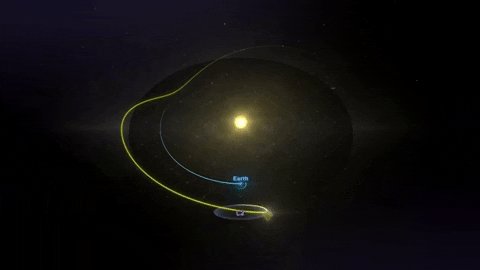
The orbit of JWST at L2. Credit: NASA
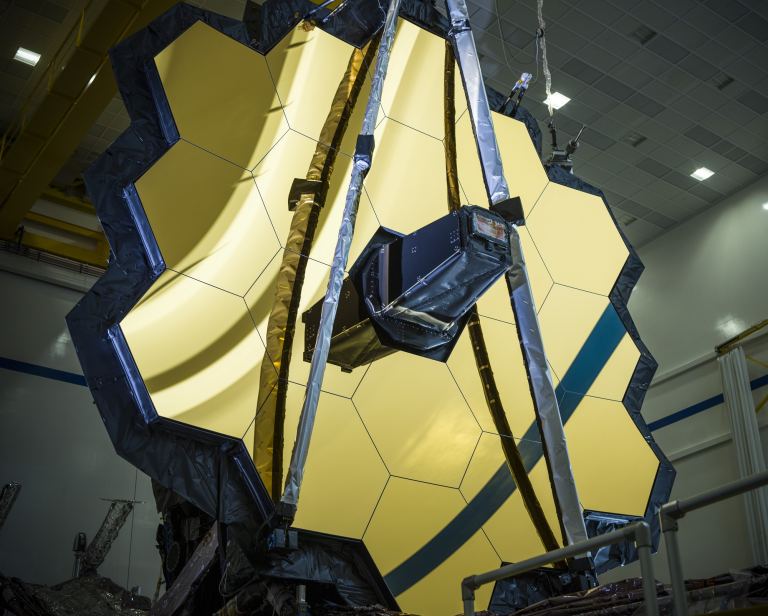
Shown with its primary mirror fully deployed, NASA’s James Webb Space Telescope is the largest and most technically complex space science telescope NASA has ever built. Credit: NASA/Chris Gunn
An Ariane 5 launch vehicle (Ariane Flight VA256) launched the James Webb Space Telescope from Ariane Launch Complex No. 3 (ELA 3) at Guiana Space Centre in Kourou, French Guiana, on 25 December 2021, at 12:20 UTC (09:20 local time, 07:20 EST, 13:20 CET). The James Webb Space Telescope (sometimes called JWST or Webb) is a large infrared telescope with a 6.5-meter primary mirror. Intended as the successor to the Hubble Space Telescope, JWST was funded by three space agencies: NASA, ESA, CSA. The telescope will be 100 times more powerful, and will incorporate improved and different technologies to capture 70% more light. Credit: Arianespace/NASA #Ariane5 #VA256 #UnfoldTheUniverse
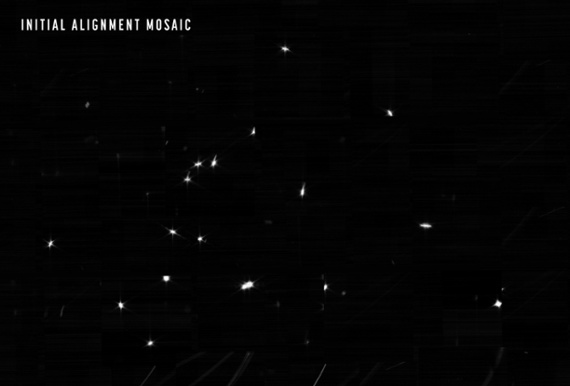
The team behind NASA's James Webb Space Telescope released some of the first images from the much-anticipated observatory on Friday (Feb. 11). The main photo, which doesn't even hint at the power Webb will bring to the universe once it's fully operational, shows a star called HD 84406
The James Webb Space Telescope has beamed imagery from Lagrange Point 2 (L2) of the first star it has imaged and a 'selfie' of its primary mirror. Full Story: from space.com Credit: NASA's Goddard Space Flight Center Michael McClare (KBRwyle): Lead Producer Adriana Manrique Gutierrez (KBRwyle): Lead Animator Jonathan North (KBRwyle): Animator Michael McClare (KBRwyle): Lead Writer Michael McClare (KBRwyle): Lead Videographer Michael McClare (KBRwyle): Lead Editor Michael McClare (KBRwyle): Lead Motion Graphics
The James Webb Space Telescope finished the first major stage in its long process of aligning the observatory's 18-segmented primary mirror. A single star that the observatory looked at was deliberately rendered 18 times into a hexagonal shape. Eventually, those 18 images will perfectly align into a single, sharp focus, but the interim result portrays a star repeated perfectly in a hexagonal pattern reminiscent of a stunning celestial snowflake. "The resulting image shows that the team has moved each of Webb’s 18 primary mirror segments to bring 18 unfocused copies of a single star into a planned hexagonal formation," NASA officials wrote in a blog post Friday (Feb. 18, 2022).
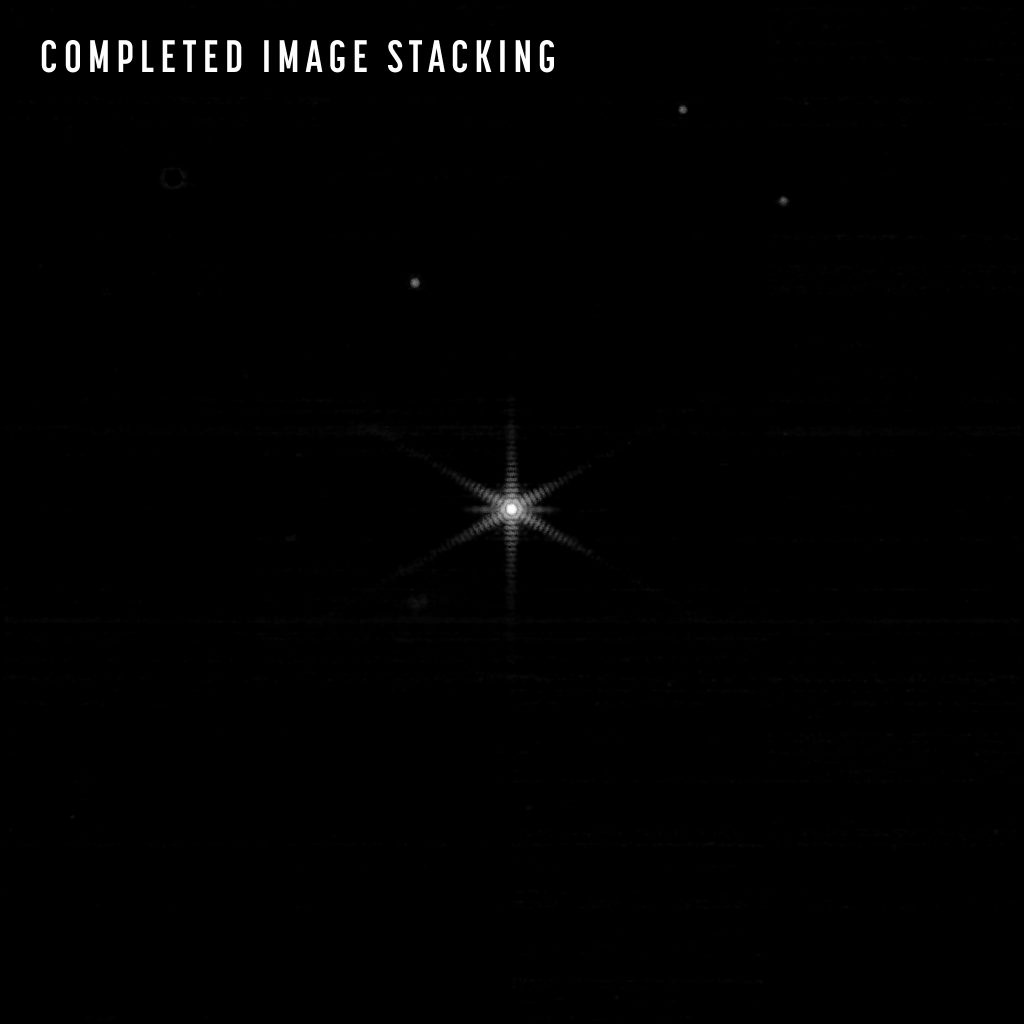
It’s coming together! Engineers for the James Webb Space Telescope have now completed two more phases of the seven-step, three-month-long mirror alignment process. This week, the team made more adjustments to the mirror segments along with updating the alignment of its secondary mirror. These refinements allowed for all 18 mirror segments to work together — for the first time — to produce one unified image.
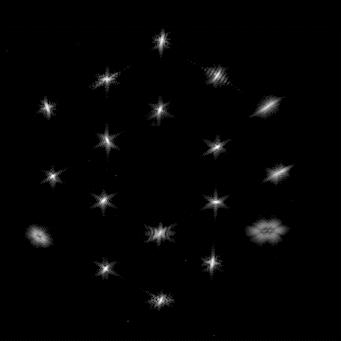
Before and after Segment alignment. Credit: NASA/STScI
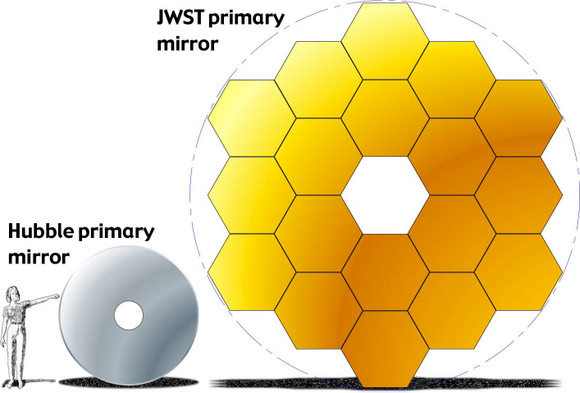
WST primary mirror size compared to the Hubble Space Telescope. Credit: NASA
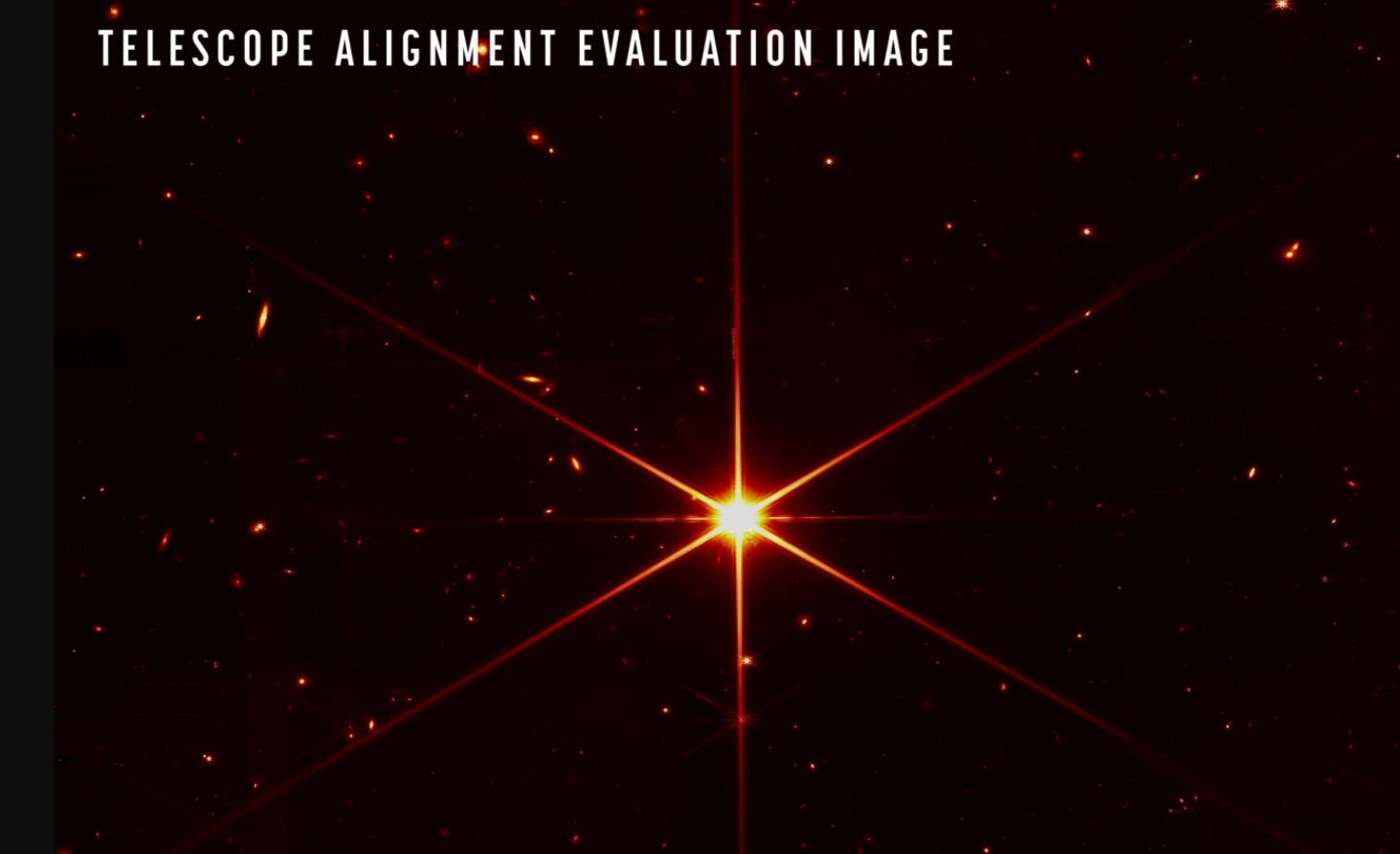
Engineers and scientists for the James Webb Space Telescope have completed two more steps in the telescope’s primary mirror alignment process, and in a briefing today, officials said JWST’s optical performance appears to be better than even the most optimistic predictions.
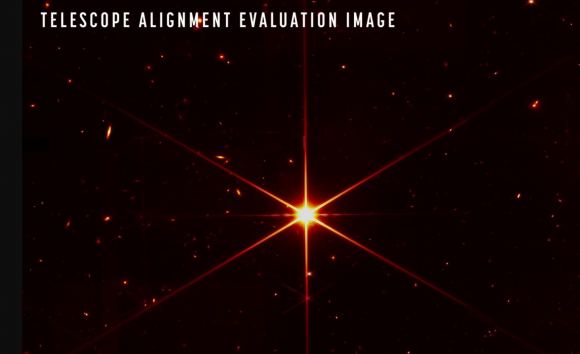
A JWST engineering image of the star 2MASS J17554042+6551277, uses a red filter to optimize visual contrast. Credits: NASA/STScI
Following the completion of critical mirror alignment steps, the James Webb Space Telescope team has great confidence that the observatory’s optical performance will meet or exceed the science goals it was built to achieve. On March 11, 2022 the Webb team completed the stage of alignment known as “fine phasing” – and at this key stage in the commissioning of Webb’s Optical Telescope Element, every optical parameter that has been checked and tested is performing at, or above, expectations. The team found no critical issues and no measurable contamination or blockages to Webb’s optical path. The observatory is able to successfully gather light from distant objects and deliver it to its instruments without issue. Although there are months to go before Webb ultimately delivers its new view of the cosmos, achieving this milestone means the team is confident that Webb’s first-of-its-kind optical system is working as well as possible. Read more: Music Credit: Emerging Discovery Instrumental by Carter / Universal Production Music Video Credit: NASA's Goddard Space Flight Center Aaron E. Lepsch (ADNET): Technical Support Adriana Manrique Gutierrez (KBRwyle): Animator Michael McClare (KBRwyle): Lead Producer Michael McClare (KBRwyle): Lead Videographer Michael McClare (KBRwyle): Video Editor Michael P. Menzel (AIMM): Videographer
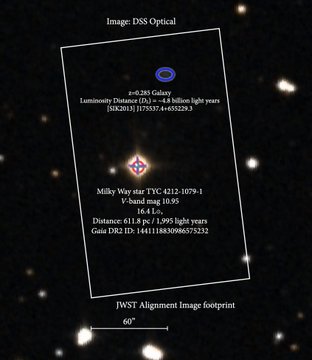
Here's more info on the @NASAWebb field. Can ID only one galaxy at z=0.285, the rest don't have spectroscopic redshifts. Deepest optical image I can find is Pan-STARRS. The milky way star distance is 1,995 light years from @ESAGaia . I've added some labels for @marinakoren et al.

If the phrase “My god, it’s full of stars” was ever appropriate, it’s today, because of these new images from the James Webb Space Telescope. These are ‘just’ engineering images, mind you, but they are incredible. The number of stars and galaxies visible in each image is just remarkable, not to mention the crisp clarity in the fields of view.
It is official, alignment of NASA’s James Webb Space Telescope is now complete. The alignment of the telescope across all of Webb’s instruments can be seen in a series of images that captures the observatory’s full field of view. Featured in this video are engineering images demonstrating the sharp focus of each instrument. For this test, Webb pointed at part of the Large Magellanic Cloud, a small satellite galaxy of the Milky Way, providing a dense field of hundreds of thousands of stars across all the observatory’s sensors. The sizes and positions of the images shown depict the relative arrangement of each of Webb’s instruments in the telescope’s focal plane, each pointing at a slightly offset part of the sky relative to one another. Webb’s three imaging instruments are NIRCam (images shown here at a wavelength of 2 microns), NIRISS (image shown here at 1.5 microns), and MIRI (shown at 7.7 microns, a longer wavelength revealing emission from interstellar clouds as well as starlight). NIRSpec is a spectrograph rather than imager but can take images, such as the 1.1 micron image shown here, for calibrations and target acquisition. The dark regions visible in parts of the NIRSpec data are due to structures of its microshutter array, which has several hundred thousand controllable shutters that can be opened or shut to select which light is sent into the spectrograph. Lastly, Webb’s Fine Guidance Sensor tracks guide stars to point the observatory accurately and precisely; its two sensors are not generally used for scientific imaging but can take calibration images such as those shown here. This image data is used not just to assess image sharpness but also to precisely measure and calibrate subtle image distortions and alignments between the instrument sensors as part of Webb’s overall instrument calibration process. Credit: NASA's Goddard Space Flight Center Michael McClare (KBRwyle): Lead Producer Sophia Roberts (AIMM): Editor Michael McClare (KBRwyle): Videographer Michael P. Menzel (AIMM): Videographer Adriana Manrique Gutierrez (KBRwyle): Animator Please give credit for this item to: NASA's Goddard Space Flight Center Music Credit: Cyclic Marimba by Eric Chevalier - Koka Media
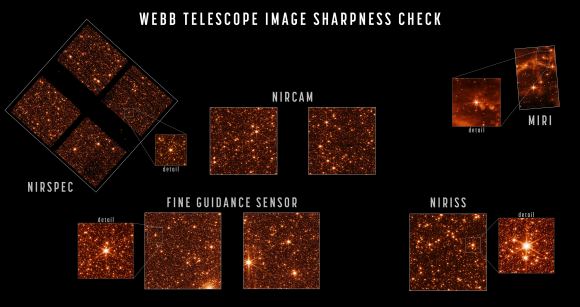
Engineering images of sharply focused stars in the field of view of each instrument demonstrate that the telescope is fully aligned and in focus.

MAY 9, 2022 BY NANCY ATKINSON The James Webb Space Telescope is now in the final phase of commissioning as it readies for science observations. Of the more than 1,000 milestones the observatory has needed to reach since launch to become fully operational, the team said today they are down to about two hundred activities to go. But those 200 are all part of the final phase of commissioning the instruments.
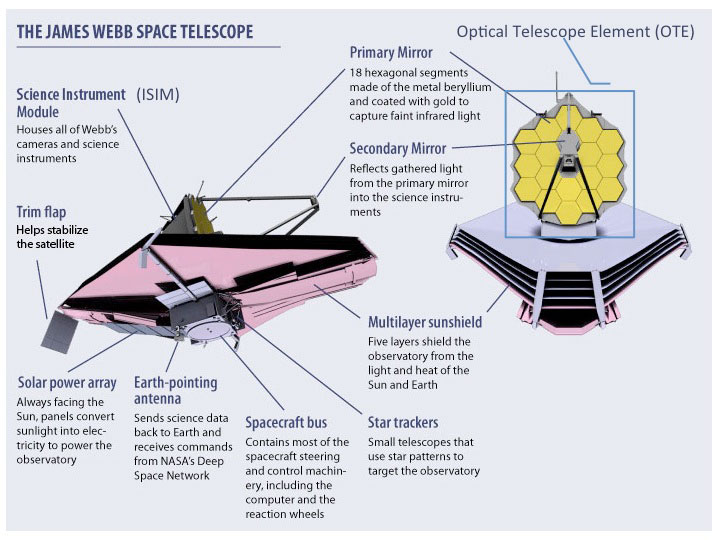
Parts of JWST. Credit: NASA
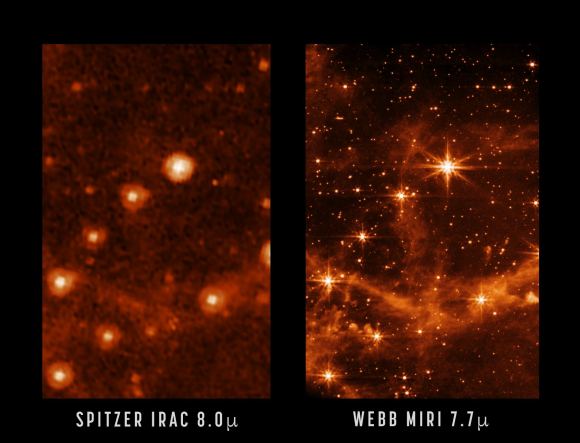
A portion of the Large Magellanic Cloud as seen by Spitzer and now JWST. Credit: NASA/JPL-Caltech (left), NASA/ESA/CSA/STScI (right)
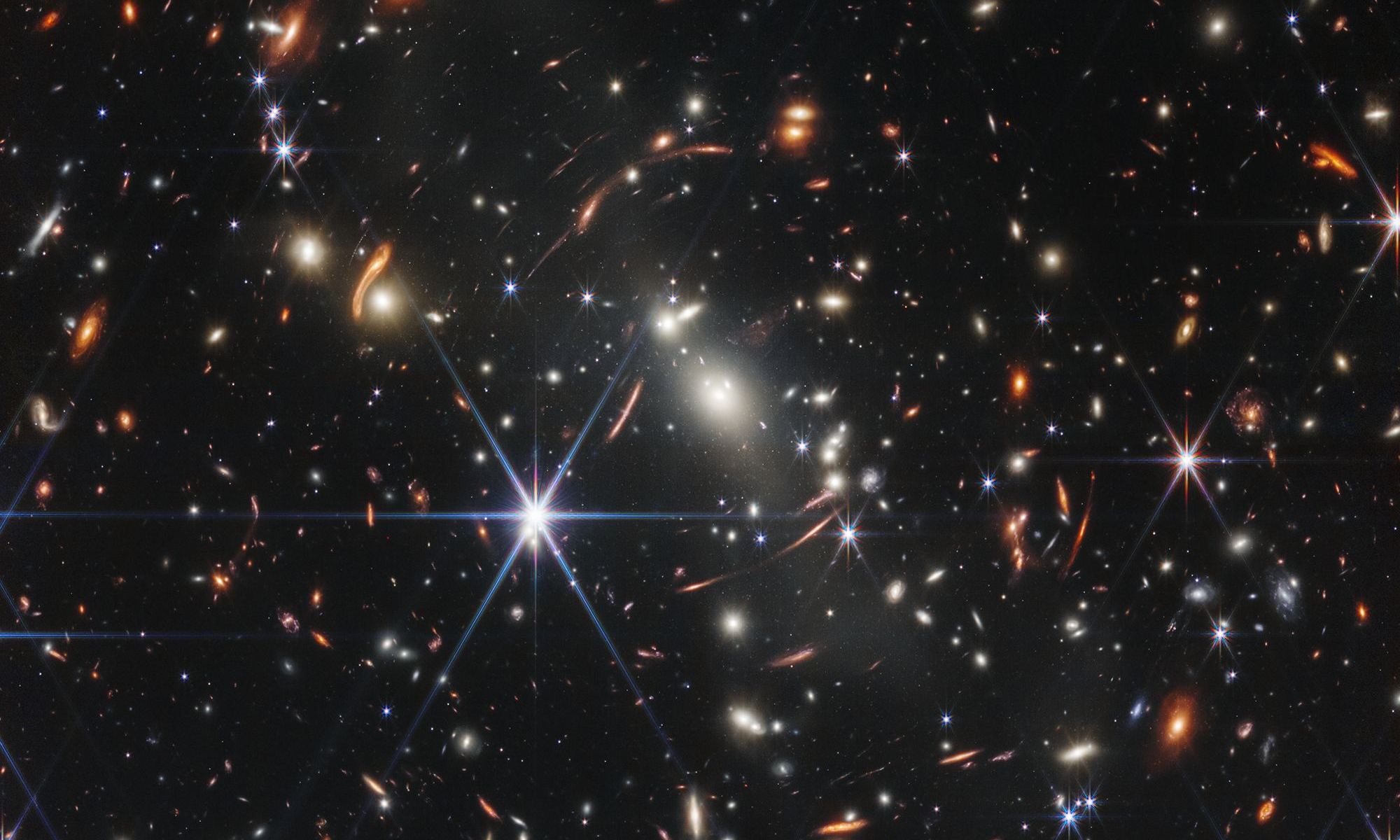
By now, almost everyone has seen the first-release images from JWST and marveled at these amazing views of the infrared universe the telescope was launched to explore. The view of SMACS 0723 seen above illustrates the promise JWST holds. While there are many more early-release images in the observation pipeline, we’re starting to see the first research papers come out. As expected, studies of distant galaxies are grabbing headlines already.
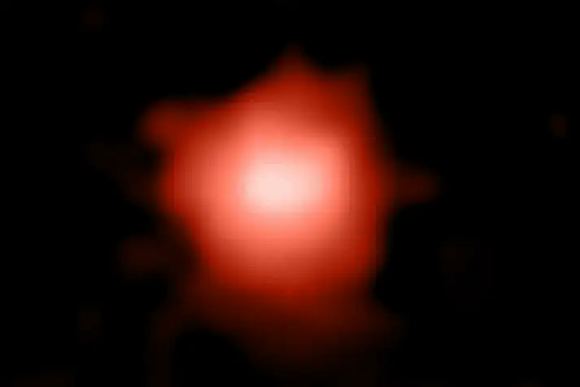
GL-z13 is a galaxy in the early universe that appears as seen by JWST when the universe was only a few hundred million years old. Courtesy: NASA, ESA, CSA, STScI
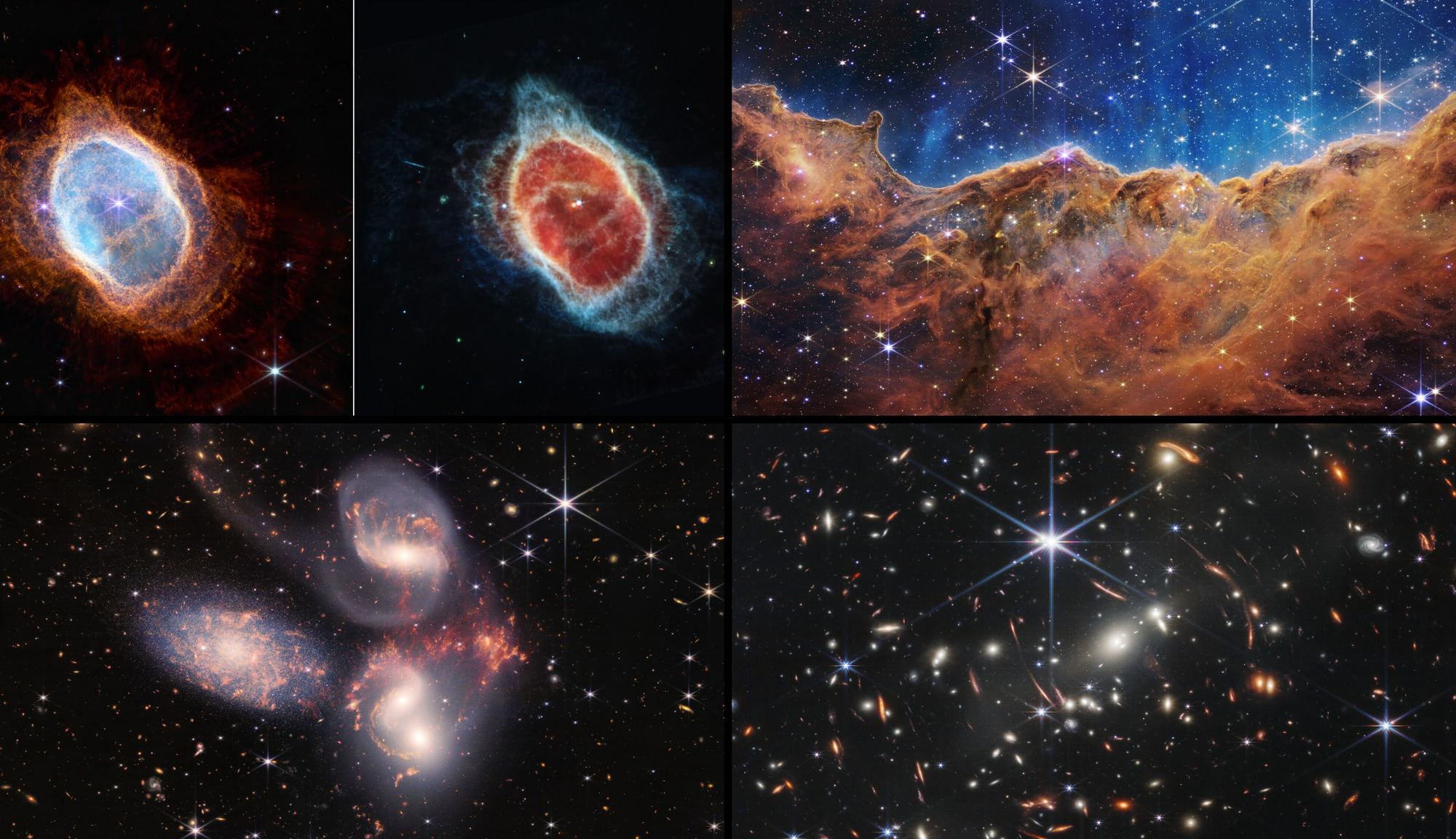
James Webb's first images! Credit: NASA/ESA/CSA/STScI
NASA finally released James Webb's first full-color images. We have 5 great photos of different regions of space. So, in this video we're digesting all the great pictures we got from JWST. 00:00 - Intro 00:49 - Deep Field 04:37 - Exoplanet 07:26 - Stellar Death 10:12 - Galaxy 12:12 - Stellar Birth 14:27 - Outro More about the first JWST images: The Big Q: JWST Interview with Noble Prize Laureate John Mather Interview with Dr. Klaus Pontoppidan Interview with Lee Feinberg, Optical Telescope Manager Interview with Lee Feinberg, Optical Telescope Manager Host: Fraser Cain Producer: Anton Pozdnyakov Editing: Artem Pozdnyakov 🚀 OUR WEBSITE: ════════════════════════════════════ 🚀 OUR WEBSITE: 🚀 PODCAST LINKS: ════════════════════════════════════ RSS: iTunes: Spotify 🚀 EMAIL NEWSLETTER: ════════════════════════════════════ Read by 50,000 people every Friday. Written by Fraser. No ads. Subscribe Free: 🚀 OTHER PODCASTS: ════════════════════════════════════ Weekly Space Hangout: Weekly news roundup with Fraser, special guests, and other space journalists. RSS: iTunes: YouTube: Astronomy Cast: Award-winning, long-running deep dive into space and astronomy with Fraser and Dr. Pamela Gay. RSS: iTunes: YouTube: 🚀 JOIN OUR COMMUNITY: ════════════════════════════════════ Patreon: 🚀 OTHER SOCIAL MEDIA: ════════════════════════════════════ Twitter: Twitter: Facebook: Instagram: Twitch: 🚀 CONTACT FRASER: ════════════════════════════════════ CONTACT FRASER: via Email: 🚀 LICENSE: ════════════════════════════════════ Creative Commons Attribution 4.0 International (CC BY 4.0) You are free to use my work for any purpose you like, just mention me as the source and link back to this video.
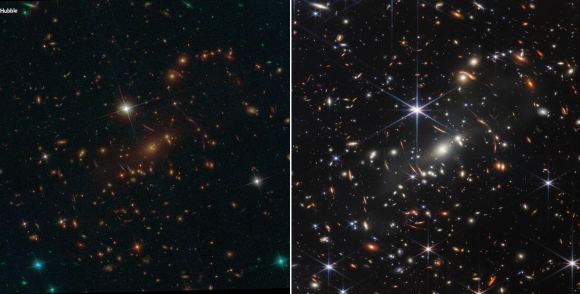
Deep Field Galaxy cluster SMACS J0723.3-7327, imaged by Hubble (left) and the JWST (right). Credit: NASA/ESA/CSA/STScI

Stephan’s Quintet, as imaged by Hubble (left) and the JWST (right). Credit: NASA/ESA/CSA/STScI
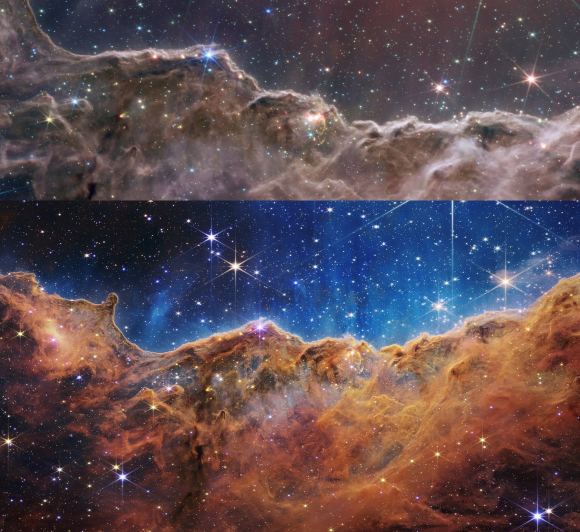
The “Cosmic Cliffs” feature in the Carina Nebula, as imaged by Hubble (top) and the JWST (bottom). Credit: NASA/ESA/CSA/STScI

The Southern Ring Nebula in near-infrared light (left) and mid-infrared light (right) from NASA’s James Webb Space Telescope. Credit: NASA/ESA/CSA/STScI
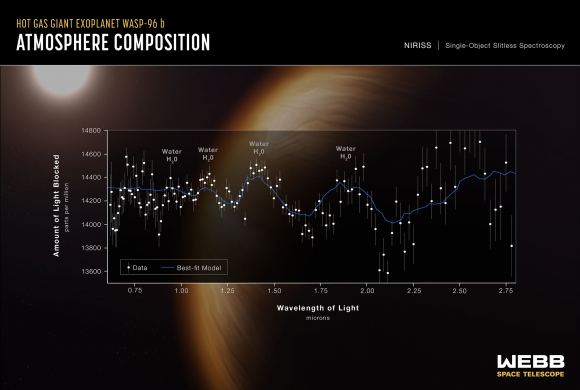
WASP-96b A transmission spectrum based on data acquired by Webb’s Near-Infrared Imager and Slitless Spectrograph (NIRISS). Credit: NASA, ESA, CSA, STScI
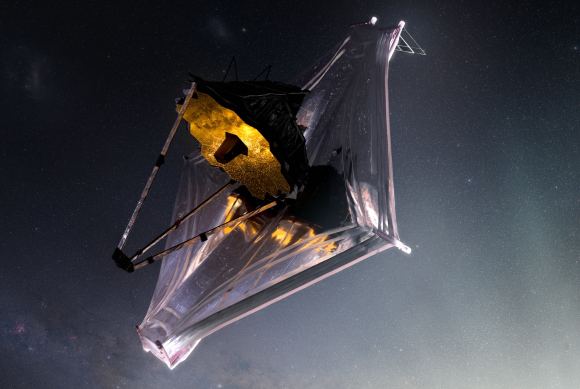
Artist conception of the James Webb Space Telescope. Credit: NASA GSFC/CIL/Adriana Manrique Gutierrez
It's already been one year of JWST operations. In this episode we accumulated all the major science results, all the amazing images and graphs, all the important discoveries and controversies. Enjoy the ULTIMATE GUIDE to the first year of James Webb. 🦄 Support us on Patreon: 📚 Suggest books in the book club: Scientist's Perspective on Webb's First Year Universe-Breaking Galaxies Interview JWST and the Future of Telescopes: Image Processing with Judy Schmidt John Mather Explains JWST 00:00 Intro 01:34 Amazing Images 13:52 Early Universe 22:26 Exoplanets 29:10 Solar System 36:32 Problems 39:24 What's Next 🚀 PODCAST LINKS: ════════════════════════════════════ RSS: iTunes: Spotify 🚀 EMAIL NEWSLETTER: ════════════════════════════════════ Read by 50,000 people every Friday. Written by Fraser. No ads. Subscribe Free: 🚀 PODCAST LINKS: ════════════════════════════════════ RSS: iTunes: Spotify 🚀 OTHER SOCIAL MEDIA: ════════════════════════════════════ Frasiser Cain's Twitter: Universetoday's Twitter: Facebook: Instagram: Twitch: 🚀 CONTACT FRASER: ════════════════════════════════════ CONTACT FRASER: via Email: 🚀 LICENSE: ════════════════════════════════════ Creative Commons Attribution 4.0 International (CC BY 4.0) You are free to use my work for any purpose you like, just mention me as the source and link back to this video.